The EASIEST NAS Software You Can Use on Your Custom NAS Server
The appeal of building your very own NAS server instead of purchasing pre-built and OS-locked alternatives from brands like Synology or QNAP, as well as ditching third-party cloud storage from Google and Apple that is subscription-based, cannot really be argued with! The savings that can be made in terms of cost, and the flexibility and customization afforded to a build-your-own/do-it-yourself solution, aren’t really up for debate. However, one thing that is debatable is just how easy the majority of open-source and hardware-free NAS software actually is! There are numerous kinds of NAS software in the market that you can choose to install on second-hand, defunct hardware and highly optimized hand-built server solutions, but despite the improved simplicity of computer building in the last decade, NAS software still continues to be surprisingly complicated, and once you break into the world of business storage, it becomes damn near inscrutable to the outsider. So today, I want to discuss five great examples of genuinely user-friendly network-attached storage software that you can install on your custom server hardware today! Some are more user-friendly than others, some are more feature-rich than others, and some split support and assistance into different tiers of access when you need it. Ultimately, these represent arguably five of the best options you have in 2024 to install software on your NAS, regardless of your level of knowledge in networking and data storage.
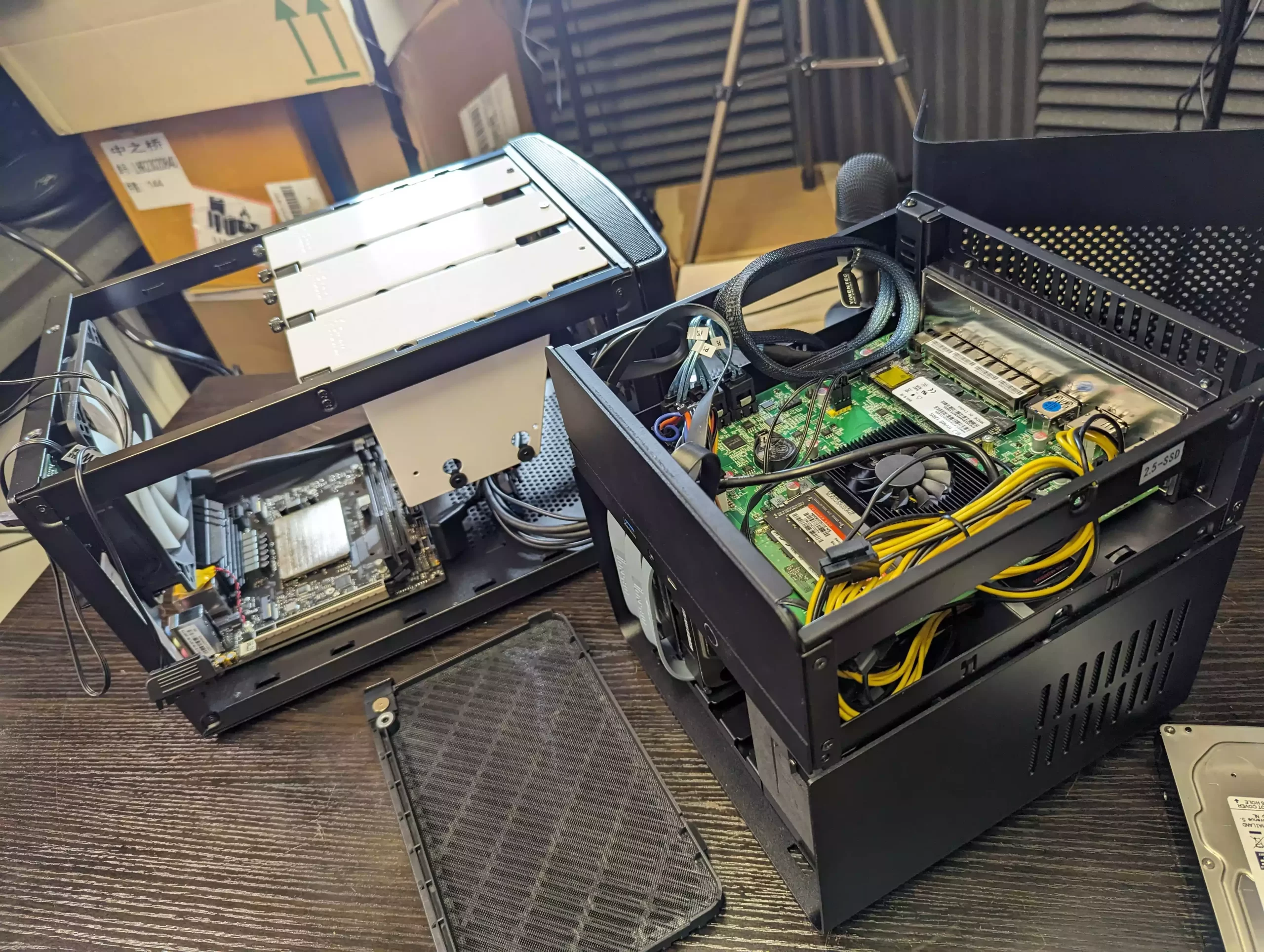
CasaOS and ZimaOS – Easy and Lite!
Price: FREE – Features 5/10 – Ease of Use 9/10 – Release May 2015 – DOWNLOAD

Arguably the second-youngest operating system mentioned in this article, Casa OS and the later, more storage-optimized Zima OS are operating systems developed by the company IceWhale. Both of them are tremendously lightweight operating systems designed to run on x86 hardware-built servers (such as Intel Celeron, Pentium, Core, Xeon, etc.) with at least 2 GB of memory to be fully utilized. Arriving with a client application for your desktop and accessible via the web browser, both can be set up and accessed within minutes of installation. There is an extremely user-friendly desktop GUI, and although the settings and configuration options feel quite limited compared with other entries on this list, if you are looking for simplicity and clarity in the way your system configuration is presented, Casa OS and Zima OS really cannot be beaten.
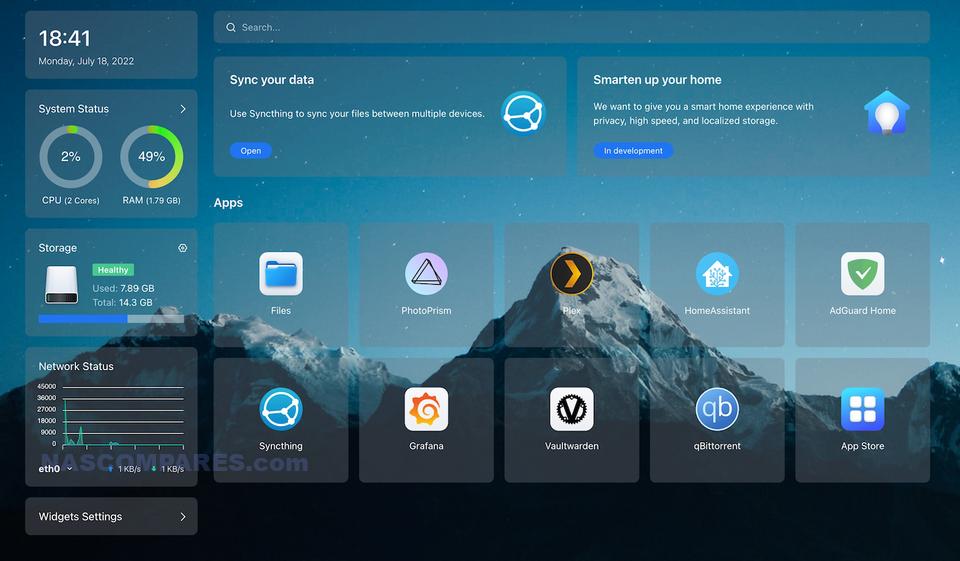

However, it’s worth remembering that this simplicity in how the information is being presented to you does echo right down to the feature set of the operating system on your server. For example, Casa OS does not (at least as of early 2024) feature any kind of RAID support across multiple drives, and RAID integration into Zima OS is still barely a few months old—a base level introduction feature in the majority of other NAS software. Equally, although file and folder level access to your data is available via a native browser application, which also includes mounting cloud spaces for synchronization, practically every other app and service you install is done so via a container repository. This in itself isn’t really a bad thing, as they still managed to make the installation one-click, but it does mean that beyond the initial OS and some arguably rather rudimentary features, the more advanced and feature-rich experience is going to involve the installation of a whole lot of third-party applications via the simplified container system.
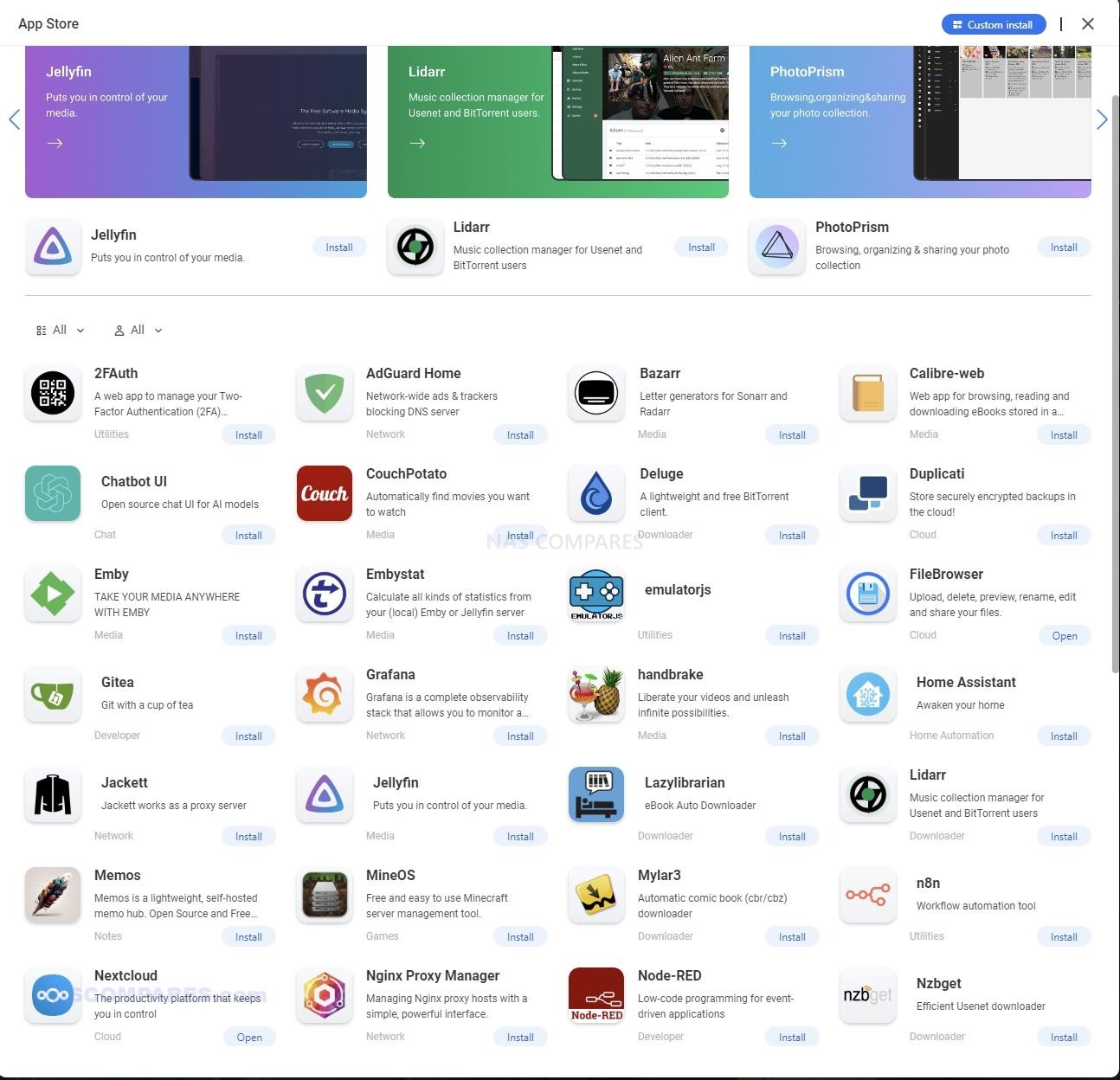
Casa OS and Zima OS are among the very few applications available in the NAS server market that are completely free, with no real pricing or subscription models that are going to get in the way of running your server on this software. Yet, despite this lack of an overt pricing model, feature and security updates are actually pretty regular. The fact that they have rolled out the more advanced Zima OS in line with their currently crowdfunded system shows IceWhale’s dedication towards this NAS OS. It is a very responsive and low-resource-consuming NAS operating system, with a very low learning curve for its introduction. But just keep in mind that what it gains in its simplicity and smooth UX, it loses in terms of a more feature-rich experience.
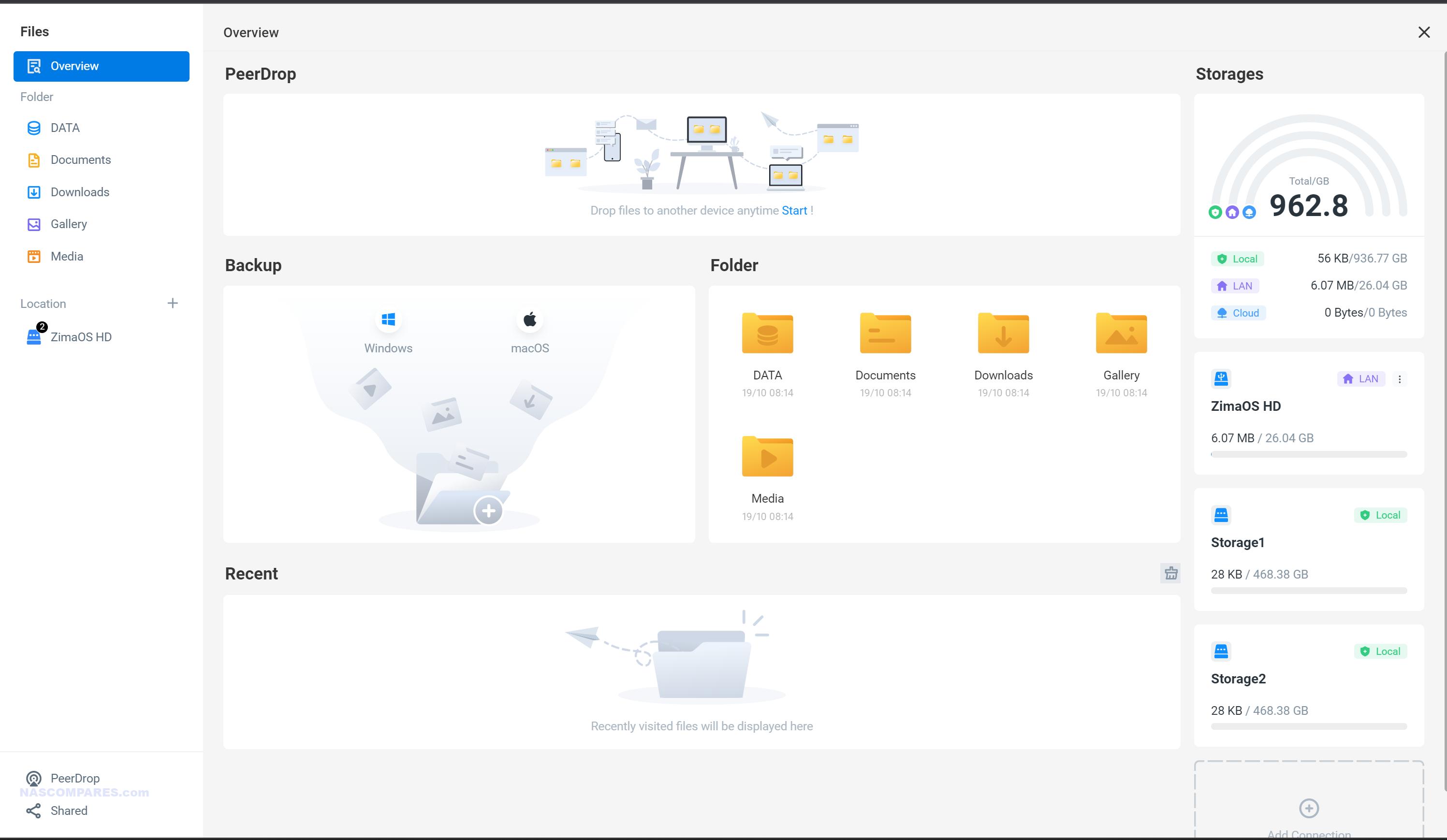
UnRAID – Easy AND Capable, YES PLEASE!
Price: 30 Day Trial, then $49/109/249 (Based on Scale/Time) – Features 10/10 – Ease of Use 8/10 – Release May 2005 – DOWNLOAD

If you have looked at any forum post, any community support forum, or any server-based education platform and asked the question, “What is the most user-friendly NAS software in the market?”, 90% of the time you will hear users say UnRAID. Everything about UnRAID seemingly focuses on efficiency and ease of use, right down to how you install the software on your custom server. Unlike a lot of other NAS software in the market that requires you to provide a completely separate SSD for the installation of the operating system, UnRAID circumnavigates this by running almost entirely on the RAM. UnRAID is installed by preparing a USB via a fantastically user-friendly client app on another computer, completely for free and created inside 10 minutes. A simple 8GB USB for a couple of bucks will be more than enough. Then you take that USB and stick it inside your newly built NAS server or second-hand old hardware you’re going to repurpose, boot the system from the USB drive, and that is it. UnRAID will deploy itself from the USB and onto the system memory. After that, you can access UnRAID via the web browser like any other server, and have access to some fantastically diverse parity and storage pool options, as well as access to one of the largest libraries of one-click containerized applications available in the market.
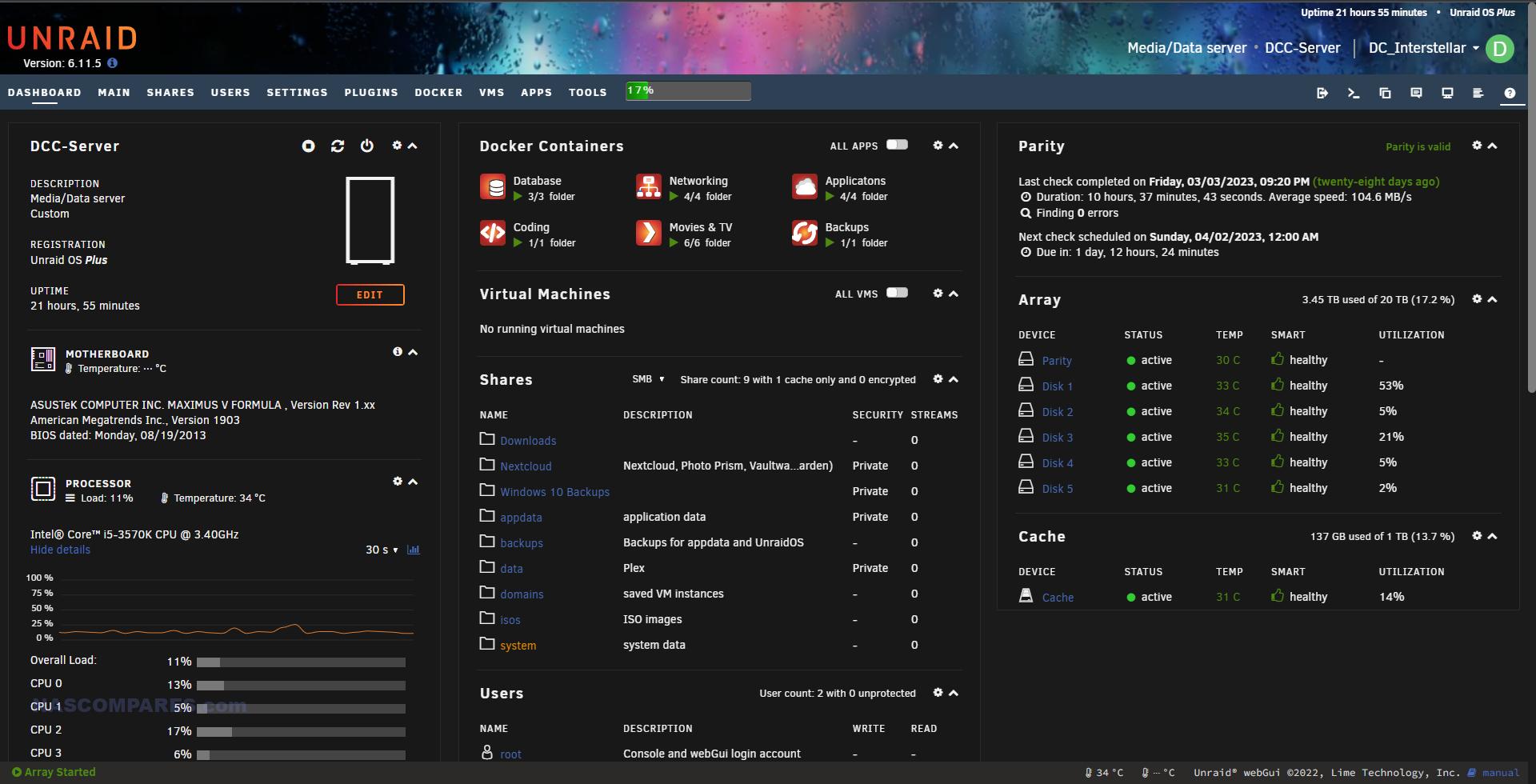
UnRAID manages to integrate numerous desirable features currently available in different NAS software in the market, but unifies them into this single software operating system. Do you want the mixed storage media advantages present in Synology DSM and Synology Hybrid RAID? No problem, UnRAID supports mixed drive deployment. Do you want the performance benefits and background stability options of Zettabyte File System but find it scarily technical? No trouble, you can mount and use ZFS storage pools in UnRAID easily and quickly. Do you want a single portal user interface that tells you the CPU, memory, user, network, process load, and everything else in a single screen, giving you everything you need to know about your system at once, as found in enterprise-grade SAN/server software? No trouble, UnRAID has this on its very first screen!
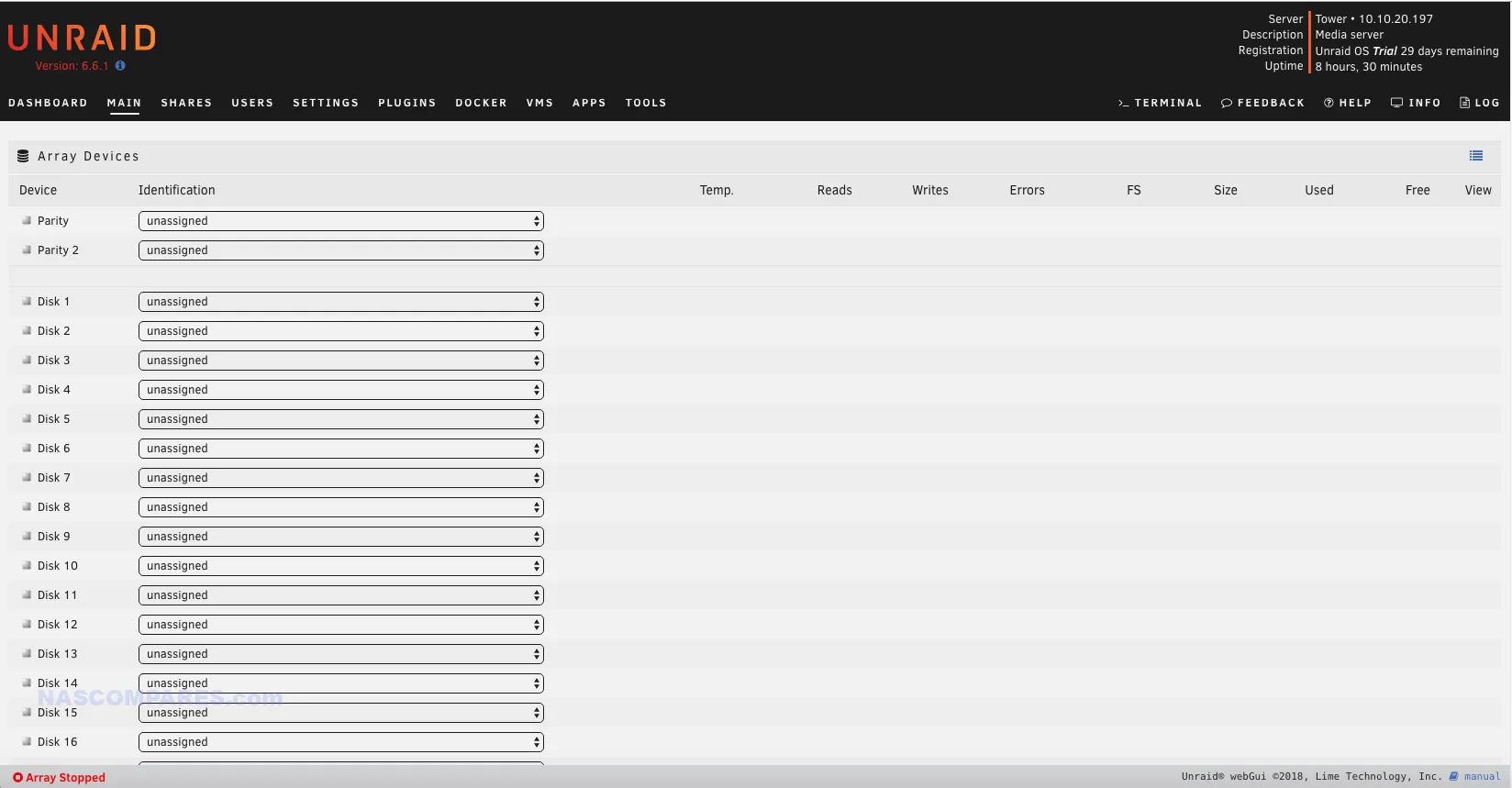
As good as all this sounds, it is important to keep your feet on the ground and know that UnRAID is by no means a perfect software platform for your NAS. For a start, although the bulk of options and server configuration/maintenance are quite intuitive and the UX has everything where you expect it to be, the initialization of your storage at the beginning is far less straightforward and the storage manager is long overdue for some kind of easy setup wizard, which is present in the majority of other NAS OS. It’s a real shame because in practically every other regard, UnRAID keeps things incredibly straightforward. Although it provides significant options to access the command line and terminal, it does not rely on these, and a lot of users can get around using UnRAID and never have to use any kind of command line beyond advanced processes and in-depth troubleshooting. Equally, there are going to be users who may balk at the idea of a subscription payment-based model.
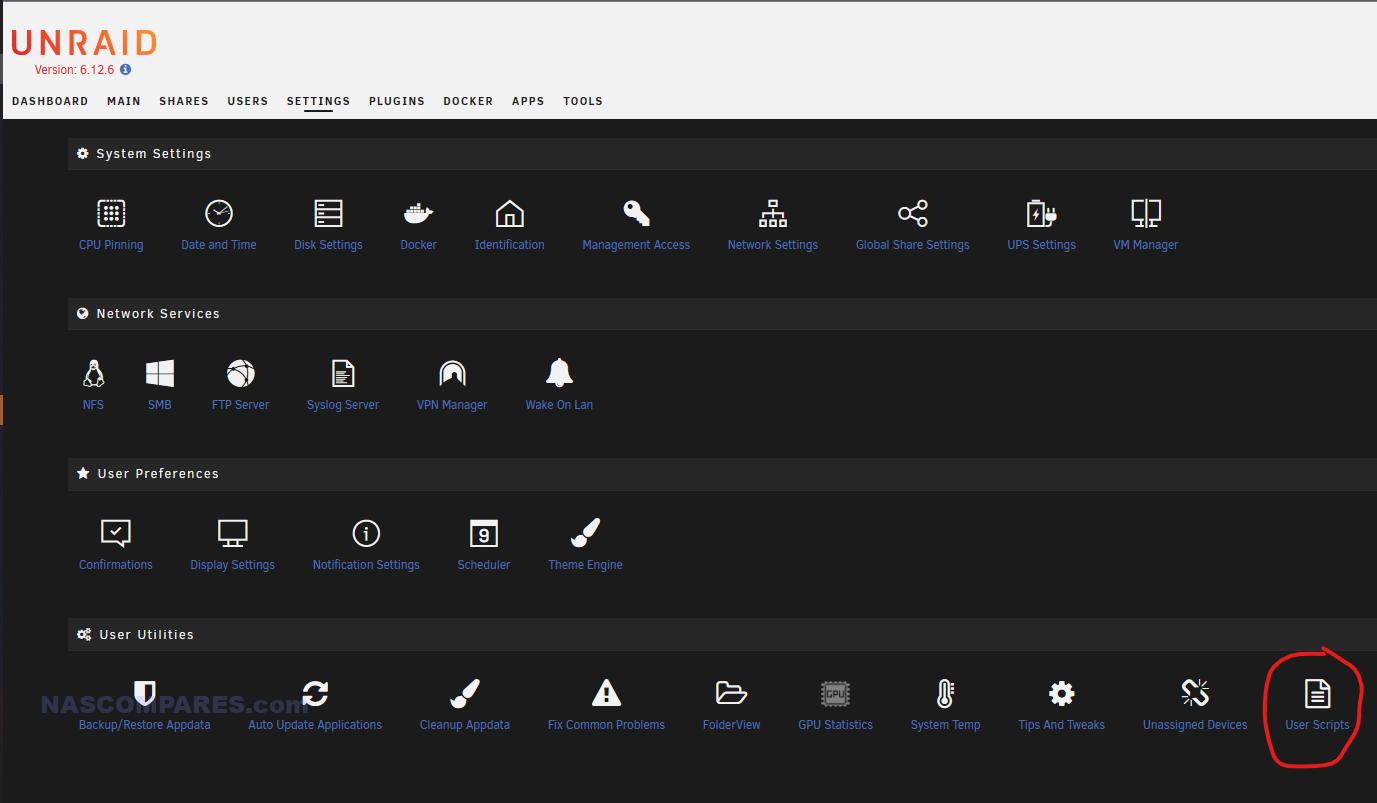
UnRAID arrives with a 30-day free trial, which given the ease of installation with a simple USB key that runs out of the RAM, isn’t too shabby. After that, subscription prices range from annual prices based on the size of your array to lifetime memberships that cost around $250. It is worth keeping in perspective that UnRAID is a lifetime OS that allows for adding infinite drives to your array, as well as moving from one hardware configuration system to the next with ease—fantastic scalability. Also, UnRAID provides services to access your server remotely and safely, and the subscription model allows for regular security and feature updates throughout the course of your usage of the software.
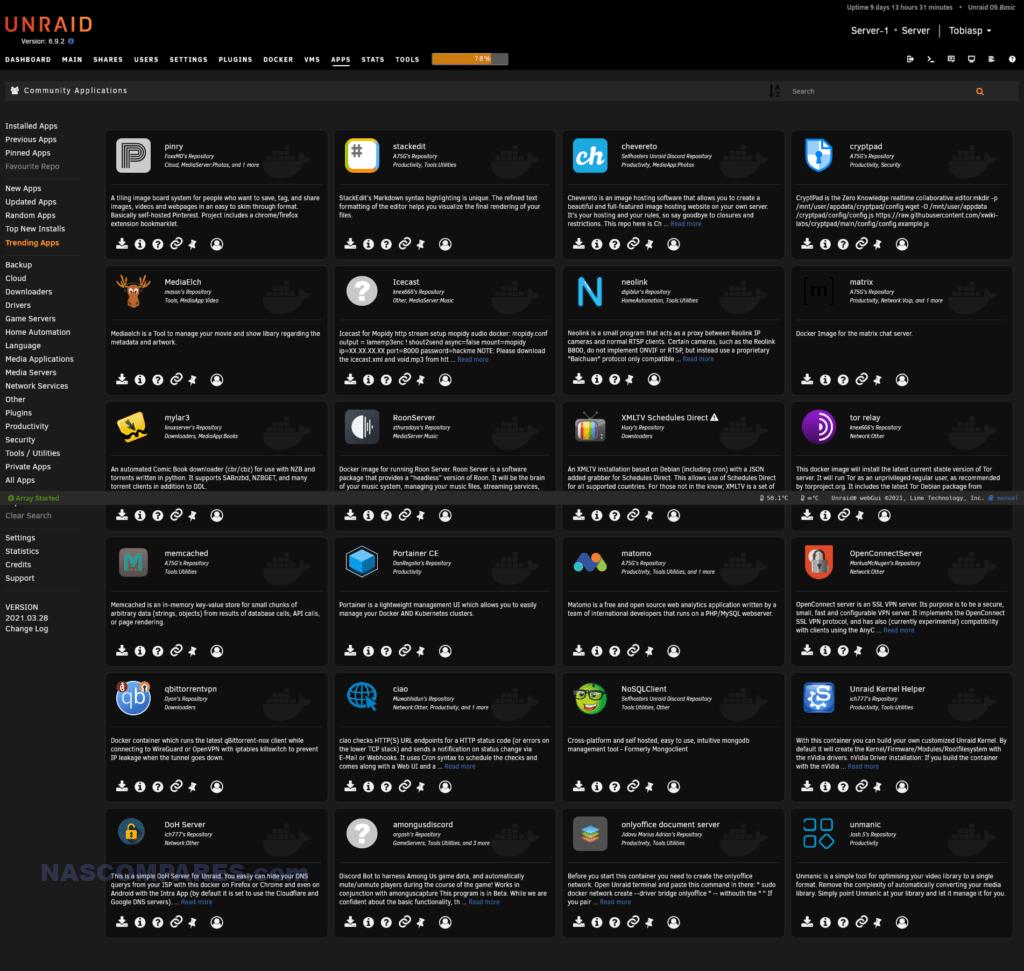
Bottom line, there is a good reason why UnRAID is still regarded as the most user-friendly yet capable NAS operating system in the market. To date, it is feature-rich, balances business features and home features, and provides the toolset to do more with it, while still maintaining high levels of usability in its base-level functions for the newbie.
OpenMediaVault (OMV) – An Oldie but a Goodie!
Price: FREE – Features 8/10 – Ease of Use 7/10 – Release May 2011 – DOWNLOAD

OpenMediaVault (OMV) is a flexible and open-source NAS (Network-Attached Storage) software designed to help users efficiently manage and store data on custom or DIY NAS systems. One of the key advantages of OMV is that it is completely free, which makes it an attractive option for users who want to avoid the costs associated with other commercial NAS solutions. OMV offers a variety of useful features, including support for multiple storage options, allowing users to set up configurations that meet their needs for data protection and performance. It also includes network services for sharing files across different devices and users, making it convenient for both home and small business environments. Furthermore, OMV supports a range of plugins that enhance its functionality, enabling users to easily add services such as media streaming, cloud integration, and backup solutions. While it might not be as graphically appealing as some other NAS software, its straightforward and functional design ensures it gets the job done effectively.
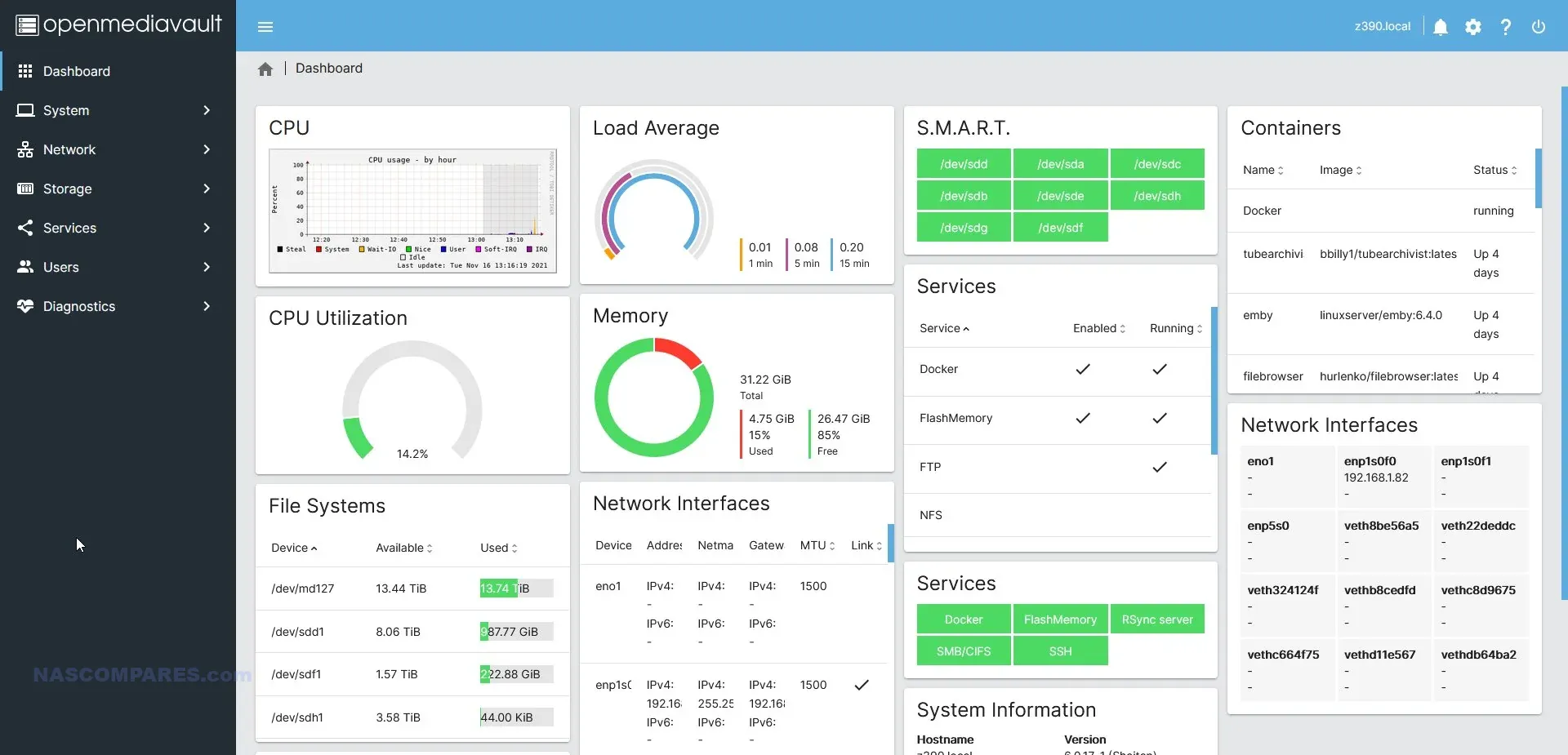
OpenMediaVault is generally considered to be user-friendly, especially for individuals who are new to setting up NAS systems. Despite its somewhat less polished appearance compared to some commercial alternatives, OMV provides a practical and straightforward interface. The installation process, however, can be a bit messy and might require more steps than some users expect. Unlike some other NAS software that offers a streamlined installation from a single USB stick, OMV’s setup may involve creating a bootable drive and configuring the system manually, which can be a bit cumbersome for beginners. Once installed, OMV’s interface is accessible through a web browser, offering a clear and organized layout that simplifies the management of storage, user accounts, and various services. This makes it easy for users to navigate and adjust settings as needed. Although setting up storage options and configuring network services might require a bit of learning for those new to NAS, OMV provides extensive documentation and community support to help users through the process.
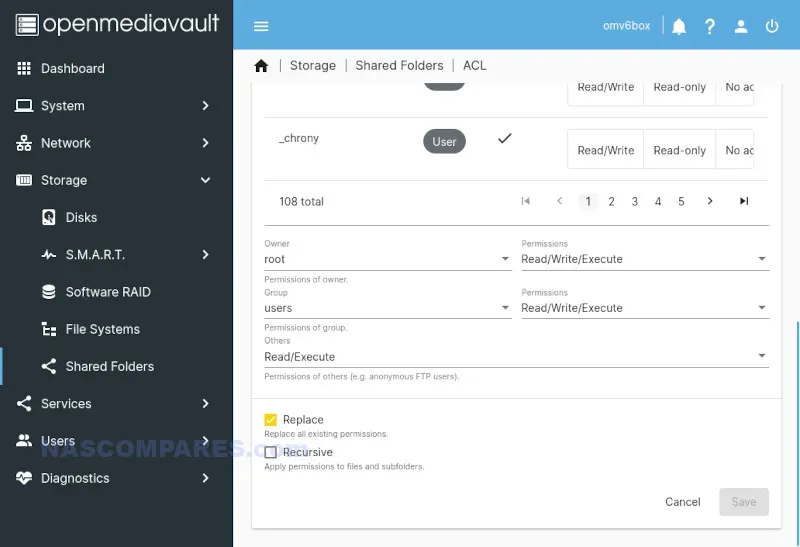
When comparing OpenMediaVault to UnRAID, several differences become evident. UnRAID is often highlighted for its ease of use and straightforward setup, which typically involves a quick installation process using a USB stick, making it very accessible for those new to NAS systems. UnRAID’s approach allows for flexible use of different types and sizes of storage drives without needing complex configurations, which is particularly appealing for users who want to mix and match their storage options. OpenMediaVault, while also user-friendly, offers a more traditional approach to storage setups and a broader range of network services and plugins, which may appeal to users looking for more control and customization. Although OMV might require a bit more effort to fully understand and set up, and its graphical interface may not be as modern or visually appealing as that of UnRAID, it provides a strong balance of simplicity and advanced features. This makes it a robust choice for a wide range of users who are interested in building their own NAS systems without incurring additional costs for software.
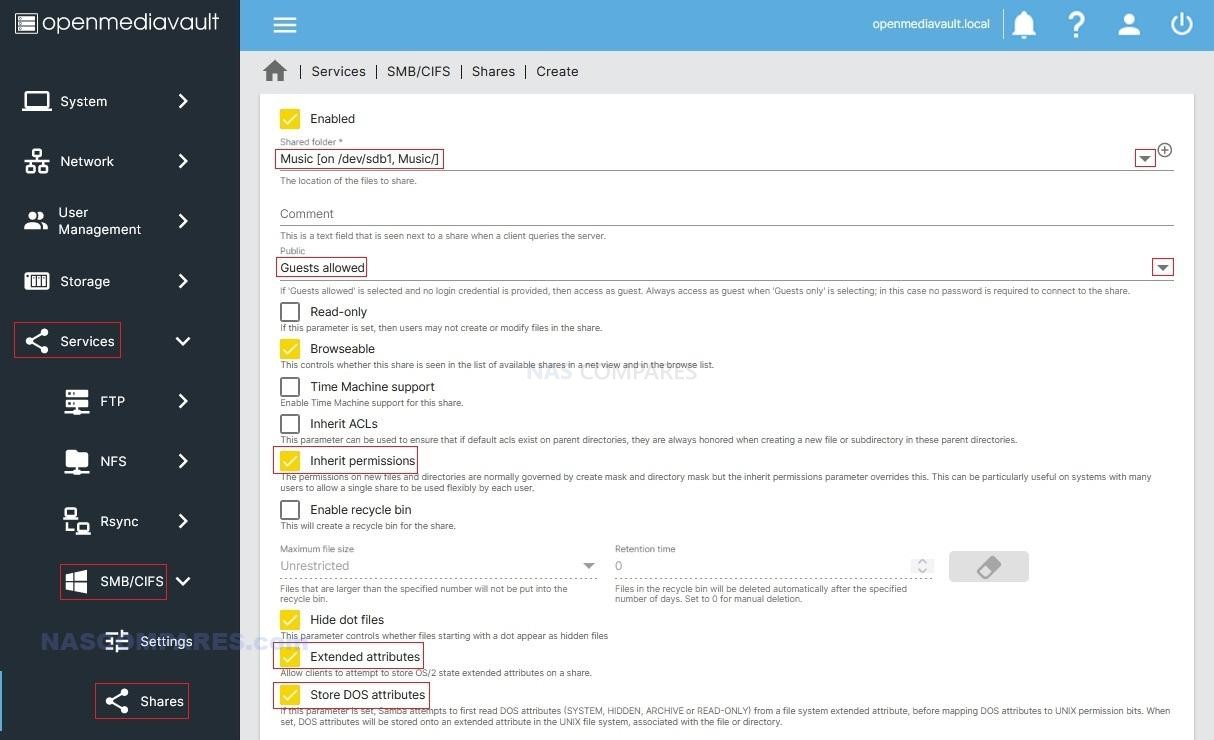
HexOS – A NAS OS Designed for Ease of Use and Performance
Price: TBC – Features 6/10 (Still WiP) – Ease of Use TBC – Release May 2024/2025 – DOWNLOAD (Beta Soon)
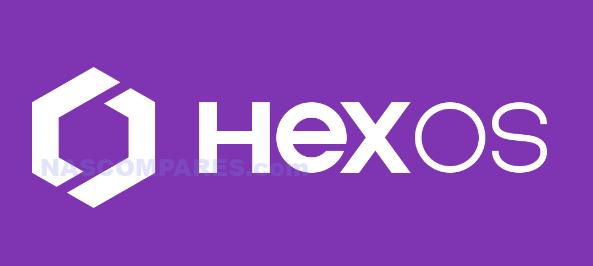
Now, this one is something of a wild card, as HexOS not only seems to be attempting to straddle multiple different elements that are present in other operating systems featured in this article, but it is also still unreleased! HexOS is an in-development network-attached storage software that is being developed by two former UnRAID team members, but is powered by TrueNAS Scale (the Linux version of TrueNAS). At the time of writing, a beta is scheduled for Q3 2024. The creators have been keen to highlight that this new NAS operating system is designed with simplicity and broad accessibility as its primary focus, hoping to combat the need for complex networking understanding and providing an extremely simplified GUI—promising to cut down on the jargon and the headaches, but still benefit from high performance and hardware freedom of use.
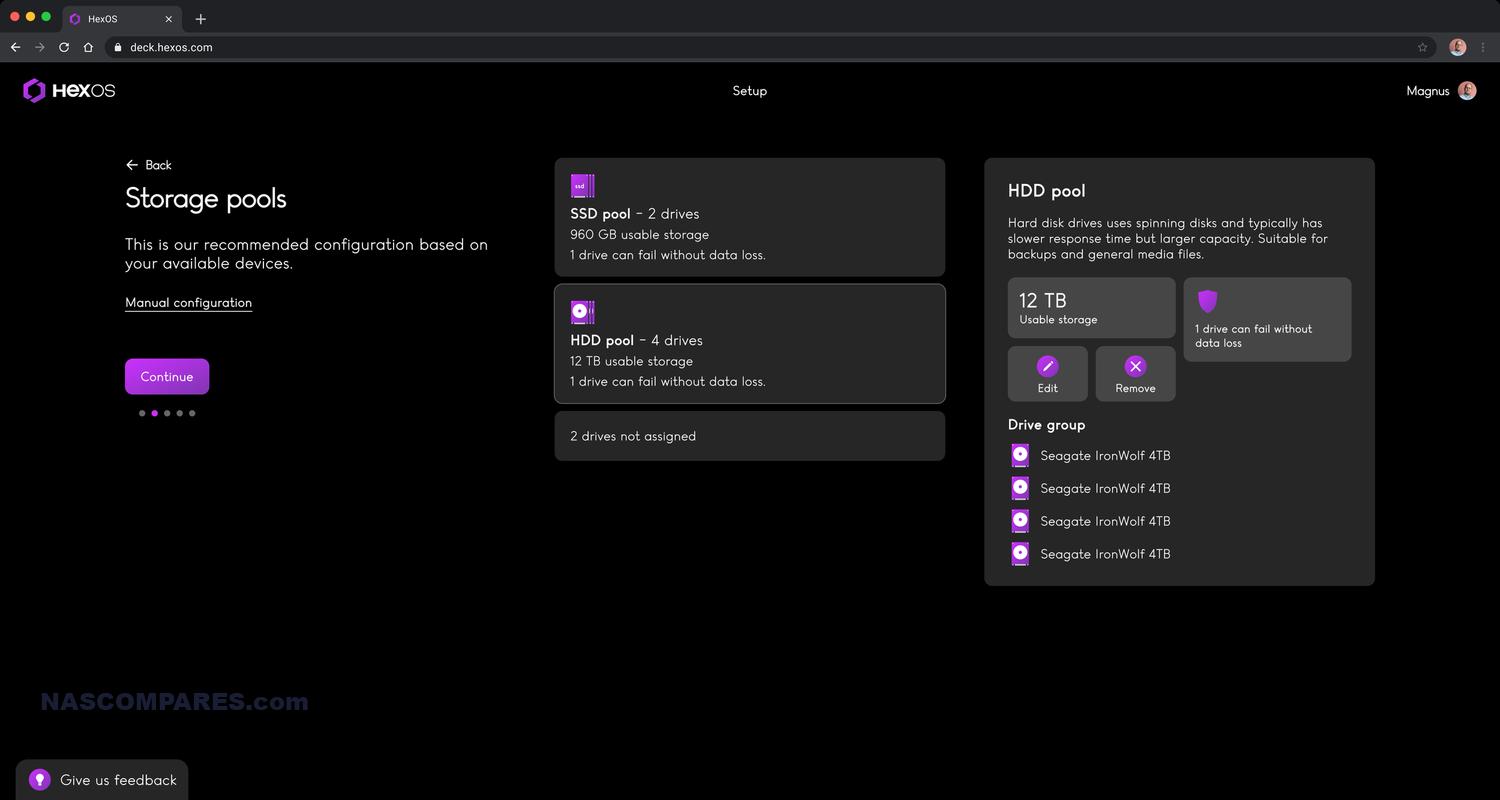
It is a very bold claim to state, and as this list and videos I’ve made online have been keen to highlight, achieving simplicity, performance, stability, and security on a network-attached storage system in a way that novices will still be able to effectively use is truly the holy grail of NAS operating systems. Early images of the intended dashboard and GUI of the software have proved promising, alongside quite bold statements as to what this software will be able to achieve while still maintaining that simplified UX.
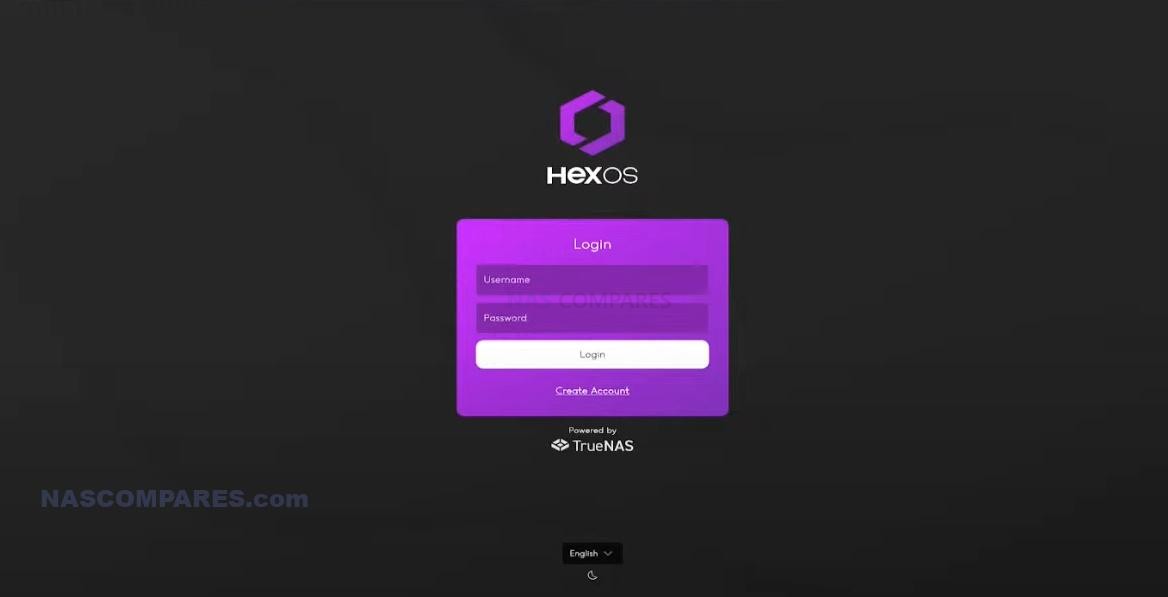
Likewise, notoriety around this in-development NAS OS was also largely increased when popular tech YouTuber Linus of Linus Tech Tips declared that he had invested $250,000 in the NAS OS startup. This, combined with the implied cooperation of TrueNAS and their platform, all add up to some intriguing breadcrumbs that could eventually lead to another great user-friendly NAS software option in the market in the next year or so.
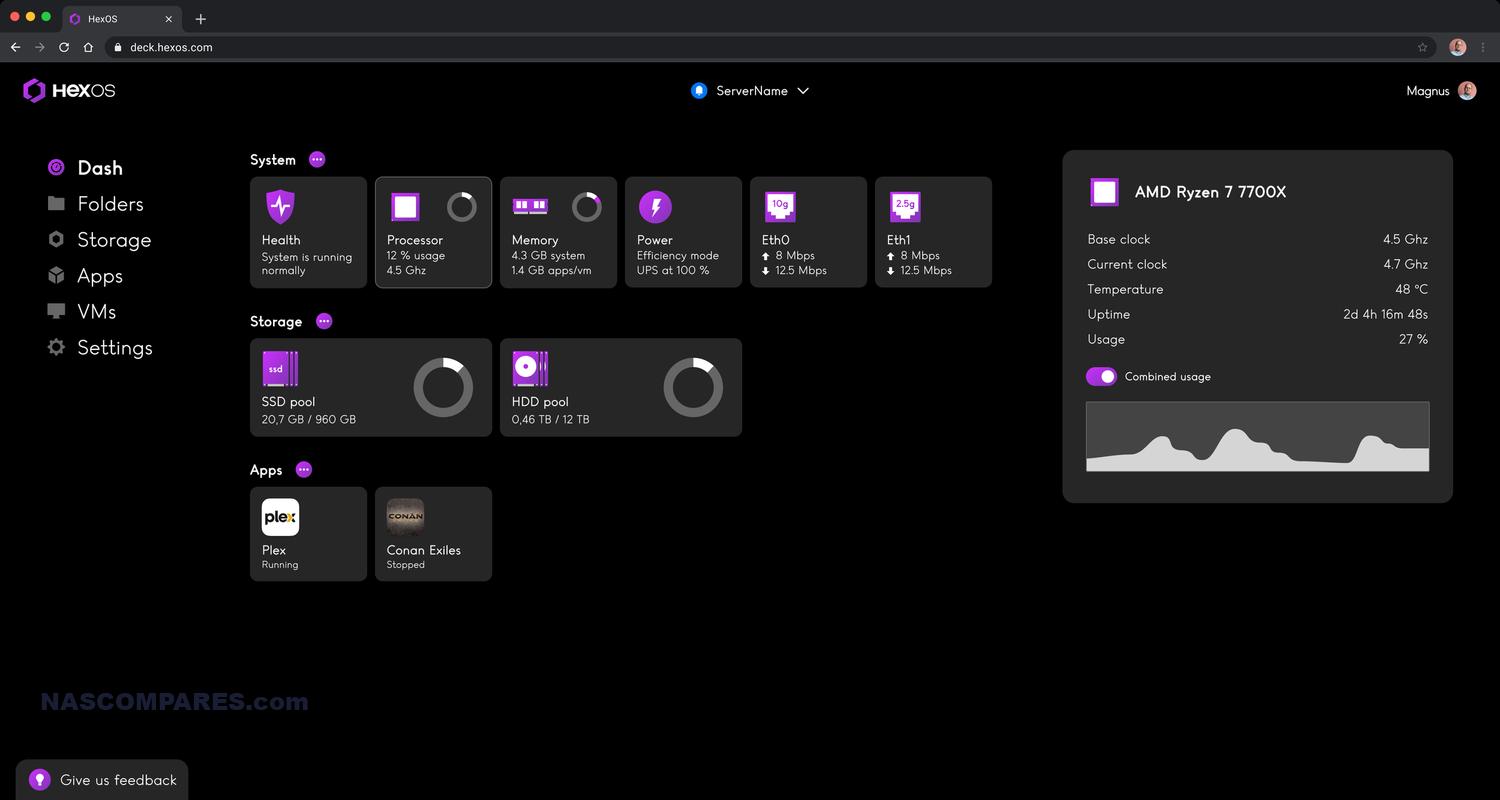
Realistically, even if this software arrives in a public beta later this year, networking software (NAS, routers, etc.) needs a whole lot of stress testing, pen testing, stability checks, QA, and troubleshooting before they can confidently be publicly released, so maybe don’t expect this platform to arrive formally until 2025. Nevertheless, I wanted to include them in this list for those who are looking a little further into the future for when they set up their own private-built NAS solution.
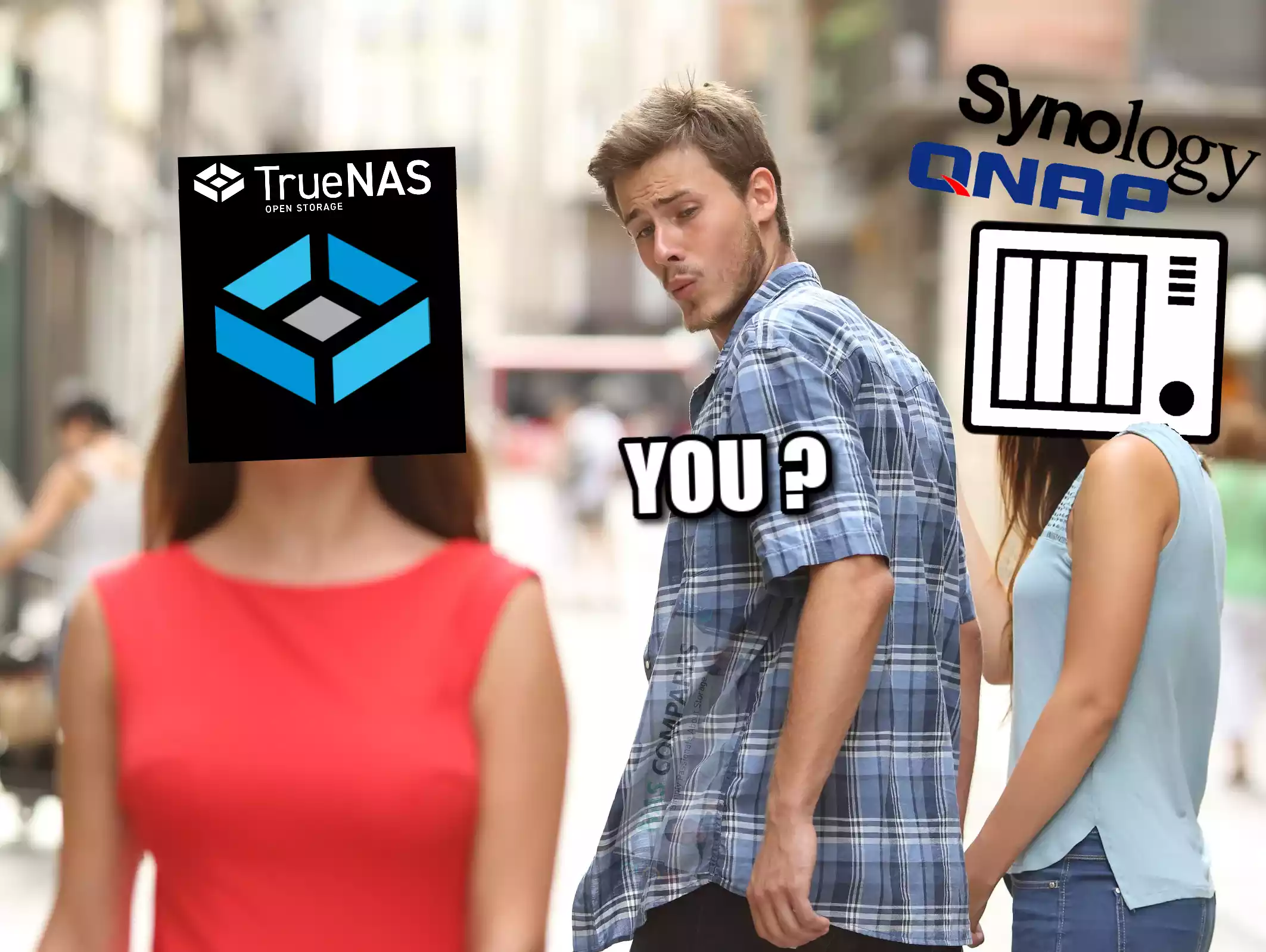
What About TrueNAS Core and TrueNAS Scale?
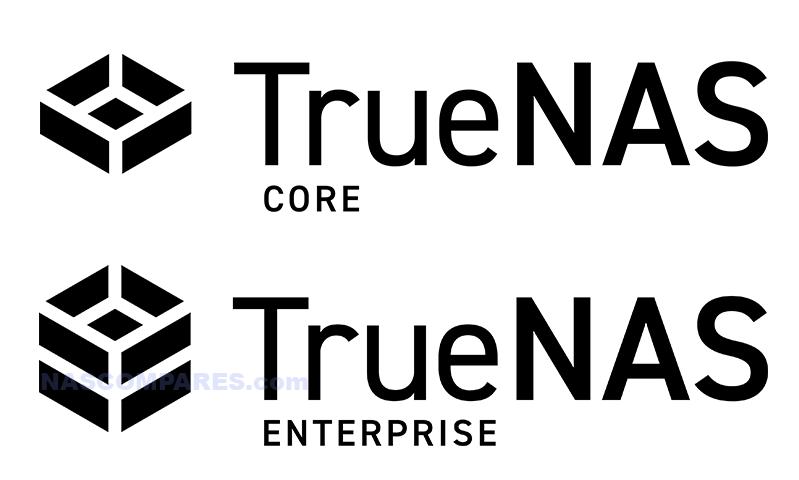
Even if you spent just five minutes looking at recommended software to install on your own DIY and BYO NAS system, chances are the NAS software TrueNAS already appeared on your radar! It would be fair to say that they are currently the number one recommended NAS operating system for those looking for a highly configurable and highly powerful private server solution. However, it would also be fair to say that TrueNAS is NOT a user-friendly platform! If you know what you are doing and have networking or data storage protocol experience under your belt, then TrueNAS Core and TrueNAS Scale won’t be too difficult to wrap your head around.
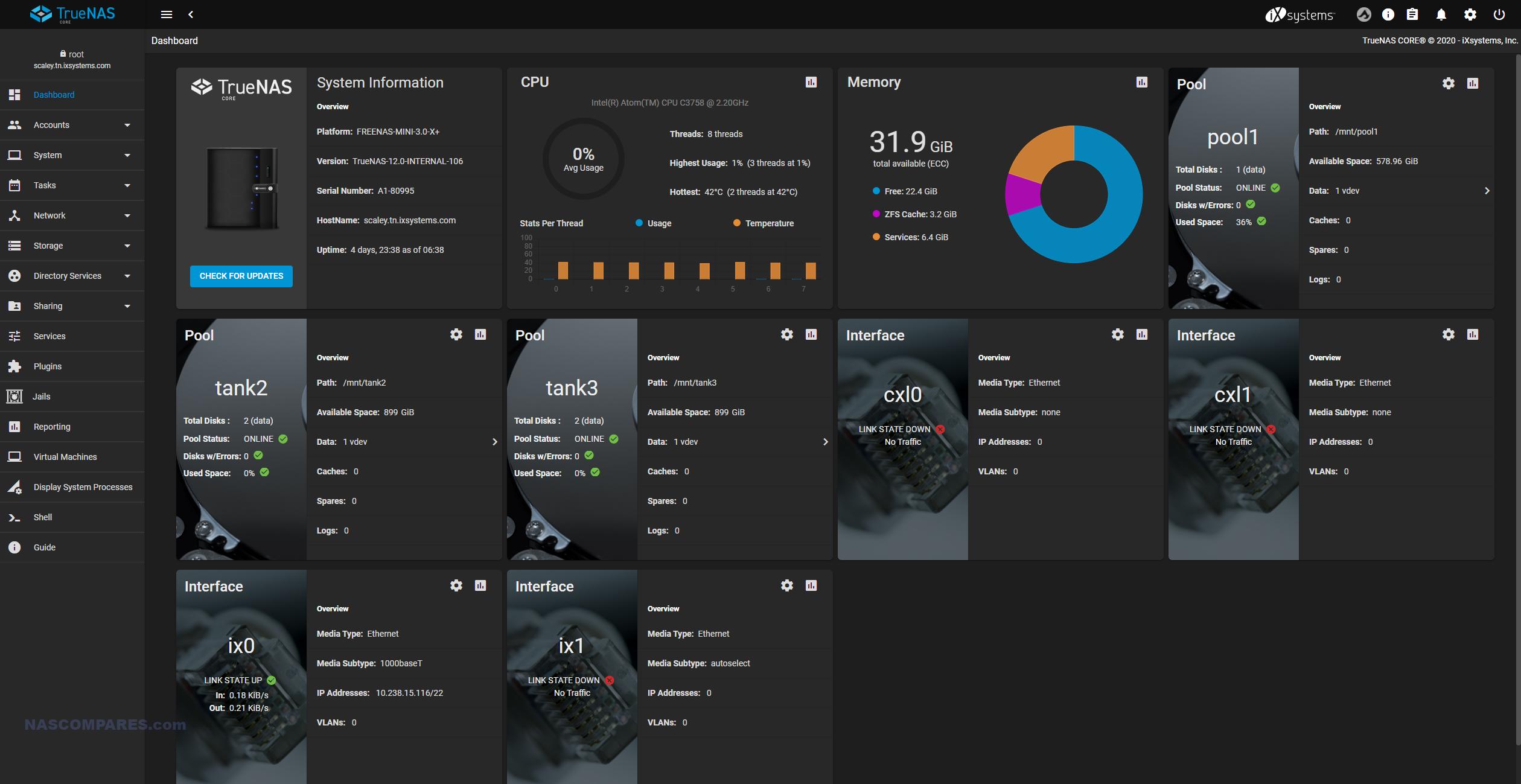
However, the majority of inexperienced or even computer amateur users are going to very quickly hit technical knowledge walls and misunderstandings very early on! Concepts such as storage pools and volumes, although very common amongst NAS OS software choices, are still presented in a very complex form in TrueNAS Core (though arguably, this presentation has been softened in TrueNAS Scale, the Linux variation). Even getting into simple storage access on a file/folder level on TrueNAS Core can be extremely complicated if you only want to manage this via the web browser. Installation of add-on applications utilizing the unique and secure jail system is noticeably more complex than in any other brand out there, and let’s not even get started on how much command line a user needs to either understand or be ready to hands-on utilize to make the most of the system.
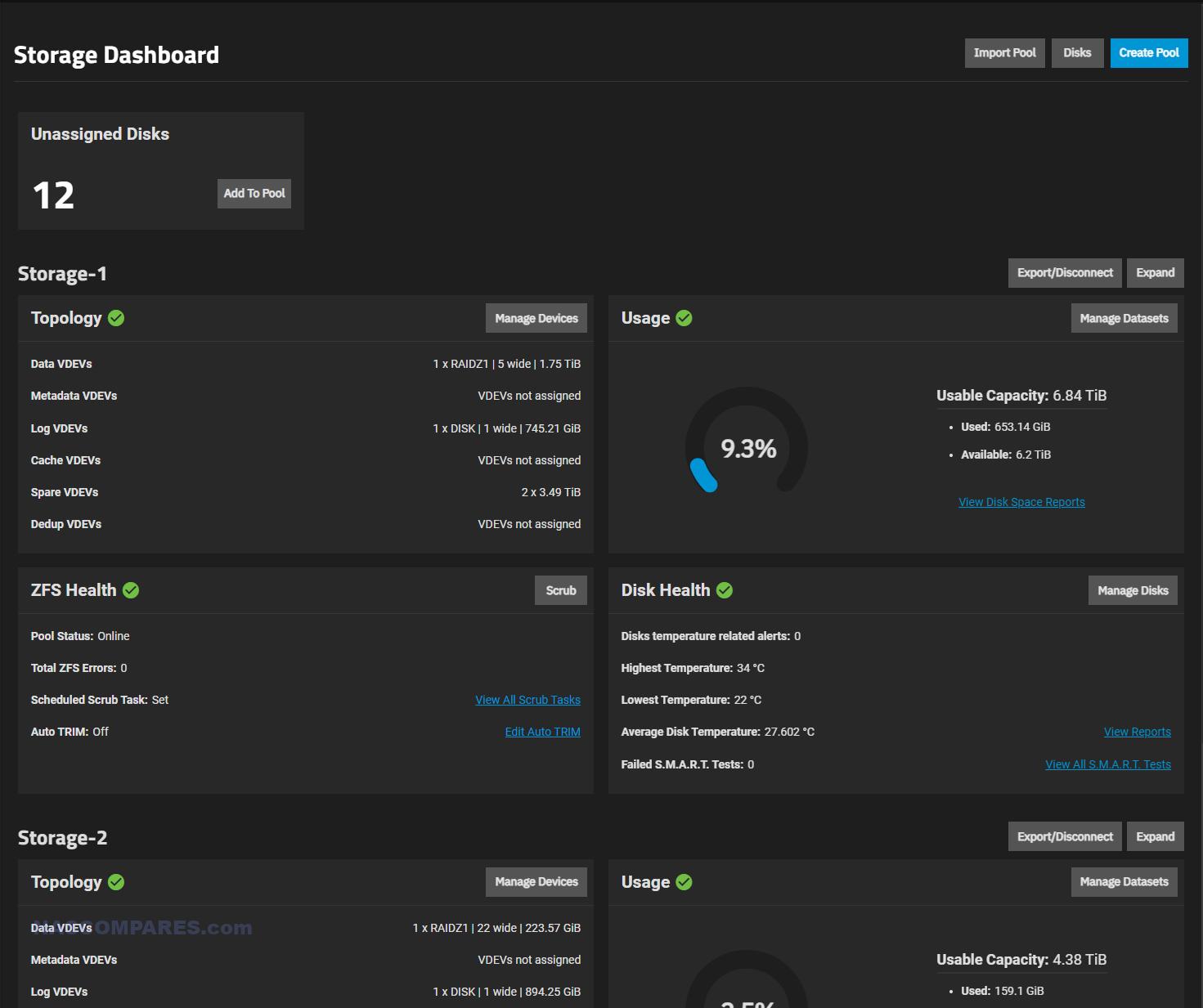
This may all sound tremendously unfair, as TrueNAS Scale and TrueNAS Core do have very well laid out and comparatively intuitive GUIs that are accessible via the web browser, allowing for a full range of control and configuration without the need for a command line. However, the language that is utilized throughout these options is nowhere near as intuitive as other options on this list. And if you are looking for software that doesn’t have a steep learning curve, TrueNAS will prove a challenge for most average users.
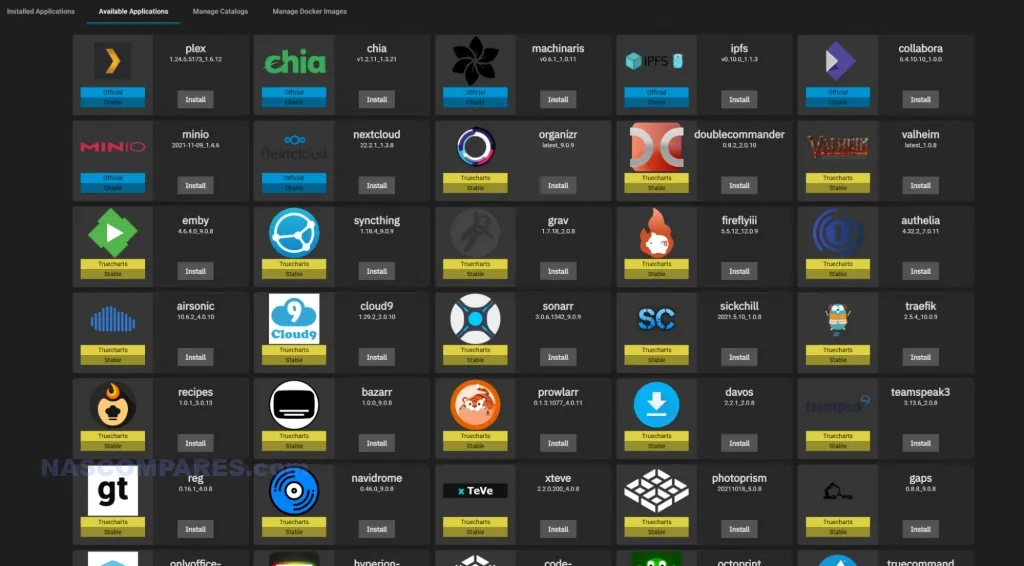
That said, TrueNAS Core and the more adaptable TrueNAS Scale are still among the most powerful and capable operating systems you will ever install on a NAS server system, and if you’re prepared to put in the hours, you are going to have a phenomenally capable and secure system at your fingertips.
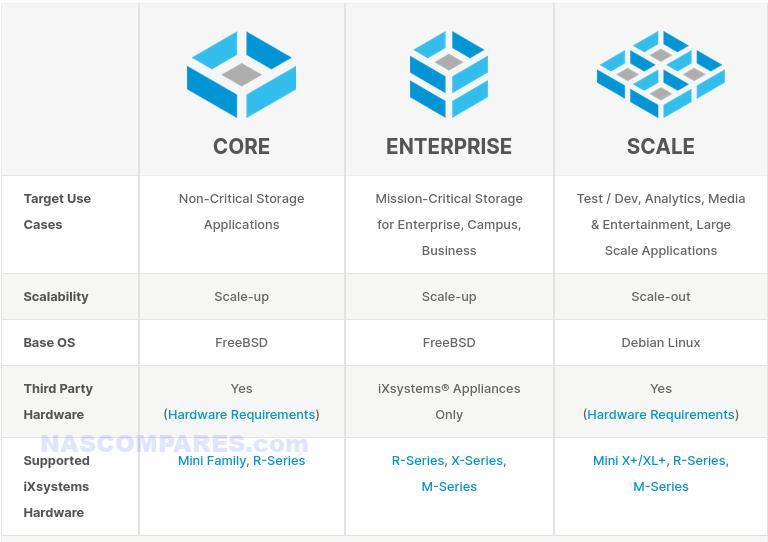
I hope you found this article helpful. Below is a breakdown of some recommended first-time NAS hardware configurations for $250, $500, and $1,000. If this article has helped you, and you want to dig a little further, there are also links below to dedicated DIY NAS and videos to help you get started on your journey towards owning your own data!
| Method | Turn-Key NAS (Synology/QNAP/etc) | Build Your Own / DiY NAS |
| ‘Out the Box’ Setup time
(i.e when it’s 100% setup complete and ready for day-to-day use) |
20-30 Minutes for Build & Initialization
10mins to 12 Hours for RAID Synchronization (ZFS = Minutes, not hours) |
60-120 Minutes for Build & Initialization
10mins to 12 Hours for RAID Synchronization (ZFS = Minutes, not hours) |
| I.T / Tech Skill Level Requirements
(Out of /10) |
Synology = 2/10
QNAP 5/10 Asustor / Terramaster = 4/10 |
TrueNAS Core = 9/10
TrueNAS Scale = 7/10 UnRAID = 6 / 10 |
| Monthly Maintenance
(Checking update, stability, logs, etc) |
10-15 Minutes | 20-30 Minutes |
| Expandability and Migration
(i.e Long term lifespan in Hardware) |
Limited to 1st Party hardware and system limitations (i.e Synolgoy DS923+ supports 1x 5-bay expansion, nothing else. Also, Synology NAS HDD/SSDs can ONLY be used in a Synology NAS)
More Expansions on QNAP, via USB or SAS Expansion Cards |
No hardware limitations (beyond actual 3rd party hardware compatibility)
Can migrate to new hardware easily and with limitless scalability (i.e, 1-1000 HDDs) UnRAID much, MUCH more expandable than TrueNAS currently. |
| Warranty and Repairs
(Options if the event of Issues and/or System Failure) |
2/3/5 Year Hardware Warranty, 1 Party (Brand)
Effective Lifetime Support and Warranty Included |
Multiple Hardware Warranty to manage (Mobo, CPU, PSU, etc)
Community led Support (Forums, Reddit, etc) Paid Support via TrueNAS/UnRAID Official Platforms) |
| Jonsbo N3 + Intel Core i5 12th Gen + 16GB RAM + 10GbE Build
Total $410.65 (i5 CPU + 16GB RAM + 2x10GbE + 400W PSU + Case + Cables) |
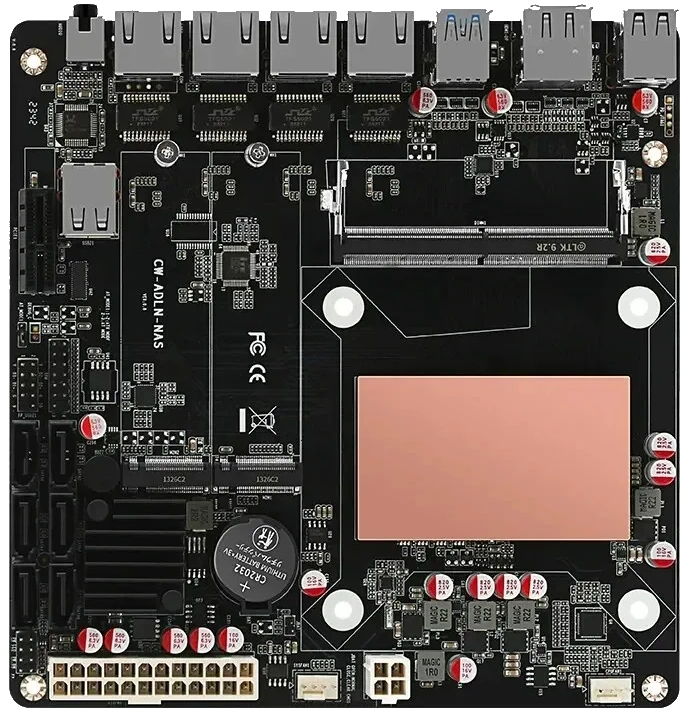
Here are ALL the Motherboard+CPU Combos that we cover in this article:
|
| Jonsbo N3 + Gen4/5 MoBo + Intel Core i5 12th Gen with Int Gfx + 32GB RAM + 10GbE Build
Total £586.63 (Amazon) + £144.76 (Aliexpress) |
📧 SUBSCRIBE TO OUR NEWSLETTER 🔔
🔒 Join Inner Circle
Get an alert every time something gets added to this specific article!
This description contains links to Amazon. These links will take you to some of the products mentioned in today's content. As an Amazon Associate, I earn from qualifying purchases. Visit the NASCompares Deal Finder to find the best place to buy this device in your region, based on Service, Support and Reputation - Just Search for your NAS Drive in the Box Below
Need Advice on Data Storage from an Expert?
Finally, for free advice about your setup, just leave a message in the comments below here at NASCompares.com and we will get back to you. Need Help?
Where possible (and where appropriate) please provide as much information about your requirements, as then I can arrange the best answer and solution to your needs. Do not worry about your e-mail address being required, it will NOT be used in a mailing list and will NOT be used in any way other than to respond to your enquiry.
Need Help?
Where possible (and where appropriate) please provide as much information about your requirements, as then I can arrange the best answer and solution to your needs. Do not worry about your e-mail address being required, it will NOT be used in a mailing list and will NOT be used in any way other than to respond to your enquiry.

|
 |
Minisforum MS-02 Ultra - WHO IS THIS FOR??? (The First 48HRs)
Why People Use TrueNAS, UnRAID and Proxmox to Turnkey NAS (Synology, QNAP, etc)
Why People Prefer Turnkey NAS vs TrueNAS, UnRAID and More
The Top 5 Mistakes NAS Buyers Make
Top 5 PLEX/Jellyfin NAS of 2025
Seagate Ironwolf vs WD Red NAS Hard Drives
Access content via Patreon or KO-FI
Discover more from NAS Compares
Subscribe to get the latest posts sent to your email.


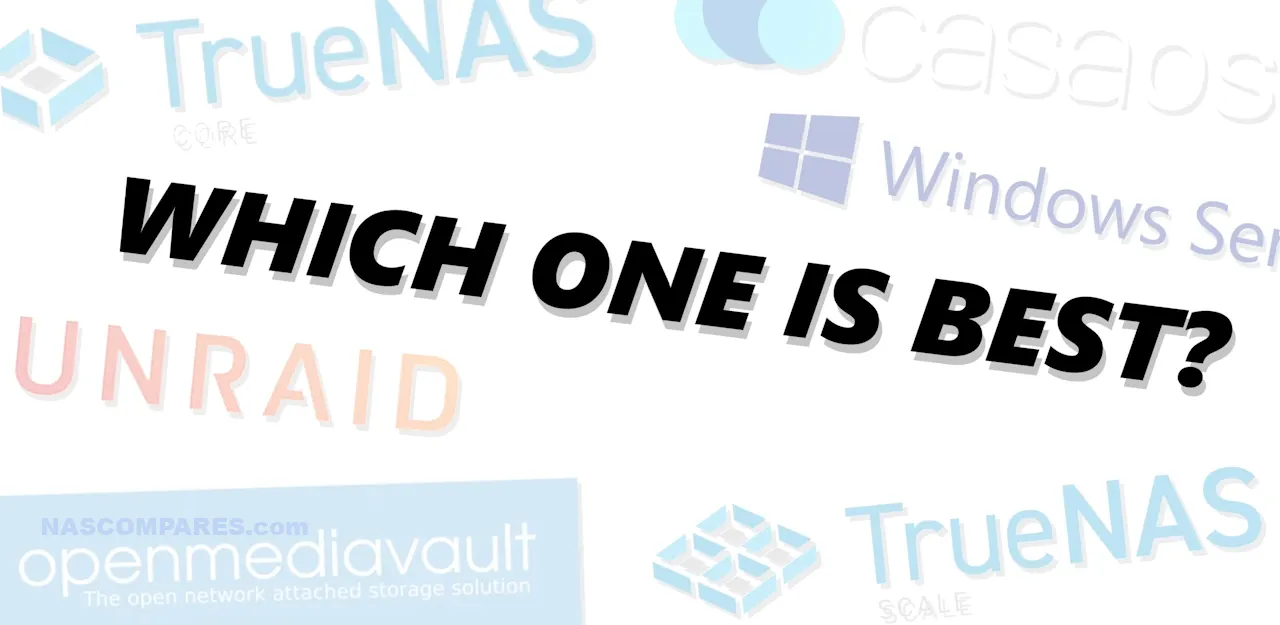
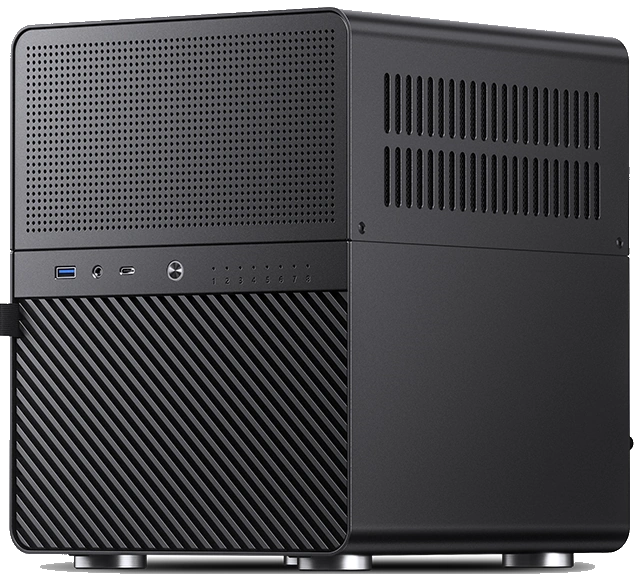



UnRAID is the perfect operating system for 1995.
After 30 years of brainwashing that an OS should look like icons on a photographic background, UnRAID surprisingly felt off the mainstream retro. I thought I would like UnRAID’s dashboard with all the information (UnRAID’s dashboard is well laid out), but with all of the conditioning of the last 30 years I found the UnRAID dashboard to be TMI, stressful and hard to focus on higher level tasks. I am a lot more relaxed working with UGOS and ZimaOS with their background and icon interface more relaxing. My frustration with UGOS and ZimaOS is the lack of books with start to finish step by step instructions once one has the hardware installed (I almost miss Windows NT Server). My current bottleneck is to set up the Docker Compose files securely, one should set up user accounts and then pass the userid number and group id number in the Docker Compose file (my model for this are the Jupyter docker containers with the jovyan user). It is easy to create a non-administrator Jellyfin user account. But, to get the user number and group number I have to run a Linux command at the BASH command line. Ok, so I just click on the terminal icon right? What terminal icon? There isn’t even one in the App Store (at least UnRAID had a way to do command line stuff). A back door method would be to jailbreak a Python docker container, but that would be exposing and relying on a huge security hole. The front door method would be to use SSH. As a one off, I could just SSH using the dynamic ip address, the username and password with the SSH command line supplied with OpenSSH on Windows Pro or Windows 11. But then I am tempted to go down the rabbit hole of setting up the SSH key pair (because?). Then of course there is the rabbit hole of folder structure and file permissions…
REPLY ON YOUTUBE
What about DIY hardware and use XPenology?
I have no experience with that combo, but does that give you the freedom of DIY and the robustness of a solid and an easy to use NAS OS?
REPLY ON YOUTUBE
I still have no regrets backing my 5-bay and 8-bay UGreen NAS’es during its Kickstarter campaign. I got them both at super early bird pricing too! I run them along with my other Synology NAS’es but I actually like my UGreen ones more now as they have improved their OS a lot. For starters, it’s much easier to set up NGINX proxy manager via docker on my UGreen NAS’es than my Synology ones. They’re a lot more powerful too! ????
REPLY ON YOUTUBE
Yes. I just bought all the components for a TrueNAS system.
REPLY ON YOUTUBE
Casa/Zima is incomplete. Simple, yes. But some of the “features” don’t work like the cloud storage integration. It will do the OAuth, but its not displaying the connection in the File Manager. Needs more work. Definitely a WIP. TrueNAS needs a setup wizard, it simply wants too much information as it assumes *every* install is for an Enterprise. Either that or let the user select a “Home Lab” or “Enterprise” option and leave out the information bloat unless needed. Unraid needs to run off a USB stick? Right. Next. OMV used to be simple and easy, but they are moving to the information bloat as well like TrueNAS. Hex wants money. It was’t reviewed, but the Turnkey Linux File Server which runs on Debian is about as simple as it gets and is very free.
REPLY ON YOUTUBE
ugreen language translation is not quite there. 02 05 03 01
REPLY ON YOUTUBE
I went down the DIY route, mainly because I really like playing with PC hardware and building stuff. I went a bit over the top, but the performance is amazing for a home setup. Using Proxmox, with OpenWRT(It’s my router) and TrueNAS as VMs. Mixture of second hand, new and hardware I already had.
AMD Epyc 7k62 48 core
256GB ECC DDR4 3200mt/s (192GB given to TrueNAS)
Asrock Rome D8-2T
2 x 512GB Intel/Adata boot drive
4 x Samsung 970 Pro 1TB (1TB usable, mirrored 3 times as it’s the NAS meta data drive)
12 x Seagate 16TB HDDs (4 x 3 VDEVs)
4 x 10GBe Intel X550 (Star topology for the house)
2 x 2.5GBe Intel I216V (For the broadband)
EVGA 1600w T2 PSU
Phanteks Enthoo Pro 2 Full Tower
Not only is this fast for a NAS, I get 10GB ethernet around my house. It’s not uncommon for me to get 900~1000GB/s over the 10GB network and in Linux VMs doing “local” NAS access I’ve seen sustained read and write speeds up to 1.5GB/s from the mechanical drives.
REPLY ON YOUTUBE
Given the case that I have for my video editing rig I can have 7 3.5″ HDD. With each HDD now having 30tb storage that would equate to over 200tb just for hard drives. I can also have 4 5tb 2.5″ HDD and with a combination of motherboard and 2 add on cards each having 4 M.2 slots that adds up to 10 M.2 with a capacity of 8tb each that adds up to a total of over 300tb storage. From Ethen.
REPLY ON YOUTUBE
Was thinking of DIY but then after reviewing some decided, nope, don’t have time and patience. Thinking of upgrading my current Synology DS418 (before that also had Synology) of switching to UGreen DXP4800 which has strong hardware but middle ground OS/software or the Synology DS425 which has mediocre hardware but strong OS/software. I am more inclined to ease of setup and use across my android mobiles, windows pc and linux notebook, which Synology provides, but then also was wanting strong hardware. Security also matters, especially where AI is local and doesn’t go to internet for its’ computation. Confused.
P.S. Xpenology on DXP4800! Viable?
REPLY ON YOUTUBE
One look at the price for Synology hardware and disk expansion cases, and I went DIY.
REPLY ON YOUTUBE
I have 3 nas. Ugreen 4800 plus, unraid with 10 disks, truenas with 6 ssd. Ugreen is the easiest to use, next unraid, and truenas is the worst in the user interface.
REPLY ON YOUTUBE
4:05 I’m not sure what you mean by the word “intensive” here. It _seems_ that you wanted to imply that CLIs are more complicated and difficult to use, but I think that is disingenuous and misleading.
Command line interfaces should be considered a selling point for novices as well as experienced users since they are invariably more stable than GUIs and much easier to document.
GUIs are better suited to displaying results than as a configuration interface.
REPLY ON YOUTUBE
Team TrueNAS. Got two self-planned and built nodes, with offsite replication and all the bells and whistles. Went full ham on a Supermicro server board with IPMI and AMD EPYC platform for the main NAS. Oh yeah, and cheap 25G fiber aswell.
REPLY ON YOUTUBE
Still cheaper to buy an old pc, add storage and use it as NAS. These pre built systems are very low power and very expensive.
REPLY ON YOUTUBE
Could you do a video on a server for £500?
REPLY ON YOUTUBE
I don’t support Synology and their recent decisions but for someone still looking to buy their first NAS, their software is unrivalled. The dropped drive support is a problem for users that have drives they want to migrate over. Taking away transcoding is just dumb though.
REPLY ON YOUTUBE
I am still running a 12 year old synology 5 bay nas, it’s been running 24/7 for almost the whole time (a few days off here and there when moving house, power cuts, or renovations). It’s got WD physical HDDs in it. The only things I’ve had to do is replace a couple of fans that have got noisy and replace one of the HDDs that failed. The hardware is no longer supported so there has been no software updates for years now. But it just keeps going so I don’t want to spend loads of money replacing something that still does the job I need it to 12 years later. As much as the geek in me would love to build a new nas I can’t justify doing it until the old one breaks ????
REPLY ON YOUTUBE
I am running my own “NAS/Server” for 10+ years… last year Ive switched to Unraid… fk Synology…
REPLY ON YOUTUBE
how is HEXOS now.. IT has been a year since it was reviewed… Anyone has any thoughts here… Time to jump synology..
also has anyone thought about going apple mini and then use it as a NAS? Lot of videos out there for that
REPLY ON YOUTUBE
If Unraid can be used in place of Ugreen’s OS(Ugreen OS is not Linux friendly) I am okay paying for it. Have you replaced a Ugreen OS with Unraid? Thanks!
REPLY ON YOUTUBE
looking at this video I just can’t help to be distracted by the ugly fingerprint catching shiny mid-2000s-design cheap plastic on the QNAP.
REPLY ON YOUTUBE
I need a stable phone sync app that doesn’t break when syncing a multiple GB sized video or some weird codec. Even QNAP fails there, seems only Synology works. It’s ridiculous really considering phone backup is so important since years.
REPLY ON YOUTUBE
I went DIY simply because it was cheaper. But It seems like I made the right decision with some of the other locked down things. But now that I have my own, I kinda want the other option as a backup of my backup. Some of those have easier sync options. I wont ever leave the DIY option cause I like the freedom.
REPLY ON YOUTUBE
I bought a CWWK AMD 8845HS motherboard, slapped on a Noctua tower cooler, 32GB RAM, 2x 512GB NVME for a cache pool and just recently dropped in a 20TB Toshiba N300 drive. On this system I run unRAID, within that OS I have multiple VMs and Containers, including a Sophos Firewall VM and a Unifi Network Controller. Basically I have a full home lab all contained within a Fractal Node 304 case. Power draw is a reasonable (80W including my Virgin Media router, a POE switch and a Unifi AP), sound level is low enough that it doesn’t upset the wife, and more importantly it has more than enough processing power to run my full home lab without breaking a sweat. Plex transcoding is handled by the AMD integrated GPU, but I don’t need any transcoding since this is a Direct Play household!
Overall I am grateful to Synology for no longer supporting 3rd party brands because that was the reason I chose not to go for a Synology NAS, and I was only looking at Synology because of SHR. Once that was no longer an option DIY was my only option.
REPLY ON YOUTUBE
I want affordable DIY cases, specifically Mini ITX or MATX. Why are these so hard to find at reasonable prices?
REPLY ON YOUTUBE
I’m really happy with my Aoostar R1 N150 running ZimaOS. I just had to replace the bottom fan with a Noctua one and put it on felt pads to make it much quieter.
REPLY ON YOUTUBE
Power efficiency is always my thing. I did pick up and old PC with a 6700 but its too heavy on thr wattage, assuming i do leave it on 24 7. I do own a mini PC which is great and pulls max maybe 10ish watts at the wall, usually 7w as it’s idle. I’d definitely go prebuilt, but I’d have to buy something that’s power efficient.
REPLY ON YOUTUBE
I’m still looking for a feature rich, AND easy to deploy and configure, AND cheap or open source NVR. It’s the one thing keeping me from scrapping my Synology.
REPLY ON YOUTUBE
Camp BYO:
Being a Windows/Unix/Linux server admin for the last 30 years, I built my own which is smaller and more powerful than the commercial offerings. First with FreeNAS/TrueNAS, then later with Proxmox and a DIY Linux LXC for NAS duties plus a whole bunch of other LXCs and VMs.
REPLY ON YOUTUBE
My NAS is jast a headless Debian server, because I like pain I guess 😀
Actually it’s because I just liked the idea of learning to manage a “proper” server. I started with Ubuntu Server and made a bit of a mess because I didn’t really know what I was doing, but second time around with Debian it really was a breeze. Now it’s a pretty clean setup with lvm, ZFS, a bunch of smb stuff as well as Plex and Jellyfin (testing before I’m confident enough to drop Plex), both with hardware acceleration for transcoding and tone mapping. Sometimes I even run some game servers.
All in all, very educational, but certainly has quite some learning curve. It also puts you in the danger zone for getting into homelab, now I’m playing around with Proxmox and OPNSense…
REPLY ON YOUTUBE
the only reason i may go for prebuild nas , is the ability to use it from outside my network over the internet , i will use dropbox , since the diy route is to complicate i have try next cloud , don t manage to make it work even truenas dose not support it , don t see any other benifits compar to a simple compute use as nas .
REPLY ON YOUTUBE
Absolutely the time for billionaire’s gold Casio
REPLY ON YOUTUBE
I’ve just built a Nas, which involved rebuilding my old PC back into its old case, and the fun of designing and printing my own harddrive rack with side loading bays. So for the cost of harddrives only (and a bit of 3d printing) I got a Nas that allows me to figure out what I need and how I’m going to use it, and to completey change my mind all I need to do is print something else. Truenas has been easy to set up and use, almost too boring really, I thought it was going to be more of a hobby but I don’t have to do anything ????
REPLY ON YOUTUBE
I’m still using my 10yo QNAP Ts-853 Pro, with added 5G network card. For HDD based NAS (which gives you shitload of storage for pennies) you don’t need anything else.
REPLY ON YOUTUBE
This is exactly what I did. Ditched Synology, bought an Intel NUC with Thunderbolt 3 external drive enclosure. Installed Linux with ZFS, NFS, Samba, JellyFin, etc. So much better than fighting with the restrictive options of Synology.
REPLY ON YOUTUBE
Easy options for someone like myself…… internal network use only… I would (now) choose the DIY route. Internal and external use the now traditional NAS solution would be best. I only use my NAS for internal network streaming, I wish I knew this b4 buying a QNAP solution..DOH ????????
REPLY ON YOUTUBE
I am looking for a nas with N355 and at least 32 giga ram. with low consumption. and 6 bay. i want also to have something safe reagrding data. then not ugreen
REPLY ON YOUTUBE
DIY is always the superior option. If you can do it, you should do it.
REPLY ON YOUTUBE
I really don’t understand “nas OS” as Linux or even windows make good nas and have far more apps.
Truenas is nice way to ease into ZFS, but btrfs keeps getting really good.
REPLY ON YOUTUBE
ditched prebuilt a few years ago now.. I’m never going back.. I was planning to move to synology but that idea died when they moved to amd cpu’s without video codecs in them…and I’m glad I escaped before the whole HD lock-in mess
REPLY ON YOUTUBE
Long time fan, first time commenter!
I’m making the move from my DS923+ (it’s been an absolute kubernetes nfs pvc permissions nightmare) to DIY. I know this isn’t discussed much on the channel, but any suggestions on a DIY setup that works well within a homelab/kubernetes setup? I’m moving my cluster to Talos this weekend and want to plan out the storage swap in the near future. Thanks for an suggestions!
REPLY ON YOUTUBE
I’m still enjoying my 1618+ but i feel that after this unit is unsupported, and in light of Synology’s recent ‘business practices’, I will investigate ‘roll your own’ options, as it were. ????
REPLY ON YOUTUBE
Thanks. I am concerned about reliability. My Lincplus N2 had issues losing some ssds, my Minisforum MS-01 is dead for seemingly no reason. All the while my 2 Synologies are chugging along, one of them for 10 years.
REPLY ON YOUTUBE
I used to think Synology for turnkey… but they don’t care about home/small users anymore, removing apps, codecs etc. (and of course their rip off for memory and the mess with disk compatibility). More and more I’m setting up open source, immich, nextcloud etc in docker as I’m in de-syno mode nowadays. When I get my next nas it sure won’t be Synology. Sorry but I’m not paying a premium for your stuff anymore. And my final, they don’t care, when the f are you going to support dark mode (yes I can use a browser extensions, but its not the point). A proper theme management so I can properly see the current line in file manager etc, uck.
REPLY ON YOUTUBE
It is unfortunate that HP stopped making MicroServers. I have a couple from the G7 era that work great as NAS devices, one running Xpenology and the other OMV. Both have Mellanox Connect-X3 10G add-in cards and run cool and quietly. Somewhat larger than a 4-bay NAS but much smaller than a tower.
For services other than network storage, I run Proxmox on a cluster of 3 1L fanless PCs.
REPLY ON YOUTUBE
Went from turn-key NAS products to DIY and will never go back. I run Plex on my NAS which leverages the GPU to handle transcoding since all my rips are 1:1 and sometimes need conversion. I remember running my huge video library through OCR software to extract subtitles because the low end CPUs in turn-key NAS boxes couldn’t even burn the subs into the video stream without the CPU being overwhelmed. With a DIY NAS you can add a GPU/iGPU to do all the heavy lifting.
I just run ZFS on top of Ubuntu server. If you are not familiar with Linux there isn’t much involved with getting ZFS running on it. The precooked NAS solutions like OMV or TrueNAS are great for new NAS users, especially if you want to run stuff in containers. I didn’t bother with those since I wanted something simple that I’m in complete control of.
REPLY ON YOUTUBE
I love the DIY way. Just received a Minisforum N5 Pro, and I also have one of the new Orico NAS in order for off-site backup. Can’t wait to get it going 😀
REPLY ON YOUTUBE
I went diy 6 months ago. Unraid, 12600k, 32GB, 80TB usable sata storage, 3 nvme zfs cache drives, windows gaming VM, plex server. Blisteringly fast and around 60w standby power consumption. Never going back 🙂
REPLY ON YOUTUBE
I’ve dreamt of doing it, but:
1) It’s not hard to bypass the HDD “lock” on turn-key systems.
2) Yes more OS options, but it’s a steep learning curve, and DIY won’t support those machines if there was a build error.
3) Hardware is getting better for DIY, but they always seem to be a larger case for HDD, and takes more PSU power which is a problem 24/7/365
4) Cost is more than just software! Sure DIY “can” be cheaper, but I’m not sure how much I’d have to save to go DIY. When the DIY doesn’t have a warranty or a customer service chat or phone number to call.
REPLY ON YOUTUBE
Are those AI title card backgrounds? I think I’m done watching this channel.
REPLY ON YOUTUBE
Kraftwerk will be coming for you using their samples! ????
REPLY ON YOUTUBE
I’ve been thinking for quite a while about building my own NAS, especially after Synology basically said ‘screw you’ to their customers. However, energy efficiency and the cost of electricity should, in my opinion, be taken into consideration when calculating the total cost. Whats your take on this and how to calcuate this?
REPLY ON YOUTUBE
Making the plunge into homelab myself and hosting my own apps and files on an NAS due to the availability of nice ITX cases and motherboards that make it very do-able without getting locked-in to a subscription or a Synology-type hardware requirement. I ended up building an 8-bay NAS a few days ago with a Jonsbo N3 case and CWWK Q670 board after various build reviews (including yours).
Some BIOS configuration snafus aside, which I was able to resolve, I have it running Linux Mint for testing purposes to verify all the hardware works. So far so good. Planning on installing TrueNAS Scale and adding 4 28TB Seagate Exos CMR drives when I have everything else configured.
Specs:
Jonsbo N3 case
2x Noctua NF-A9 case fans to replace the original case fans.
CWWK Q670 8-bay Motherboard (revised white version)
Intel Core i3 14100T (may or may not upgrade later)
Noctua NH-L12Sx77 L-Type Low Profile CPU cooler
128GB (2x 64GB) Crucial Pro DDR5 5600 UDIMM Memory
Lenovo Intel X710-DA2 Dual Port 10Gb PCIe Network Adapter Half Height (01DA902) (plus a full height bracket to swap out)
1 x Samsung 990 PRO 1 TB SSD NVMe M.2 (future boot drive – overkill but I got it on sale – I had an ancient 128gb NVMe I was going to press into service but it was not compatible)
2 x Sabrent Rocket 2TB SSD NVMe M2 (for apps pool – pulled from my workstation PC during an upgrade)
For testing purpose I threw in a couple of old SATA drives I had pulled from old systems and they were detected. One has Linux Mint installed as the boot. These will be retired eventually once I get TrueNAS Scale set up.
Planned apps:
Truenas Scale (OS)
Nextcloud
Jellyfin
Possibly Handbrake
Calibre-web
Immich
Possibly Navidrome
As far as Synology goes, I am not keen on any ecosystem (however well-designed) that requires proprietary software. The recent decision to require Synology-certified drives just hardened my stance against them. Nope. They just got added to my sh*t list alongside MIcrosoft, Adobe, Google, and Apple.
REPLY ON YOUTUBE
I bought into Drobo 15 years ago. I had a system problem and lost everything as the array broke down. DIY all the way now.
REPLY ON YOUTUBE
I would be wary of starting something then finding out that I’ve messed up and got incompatible parts. Are there any kit options that come with guidelines?
REPLY ON YOUTUBE
I would build my own if I had time to tinker with it. I love to do that. But for my current needs I just need something I can plug in, add drives and it works. That’s why I have my Synology. I plugged it in 5 years ago and it’s never been shutdown other than for cleaning or updates. Whether I’m at home or in another state it’s there when I need it. Replaces any need for Google or other cloud services.
REPLY ON YOUTUBE
Too much distracting arm waving.
REPLY ON YOUTUBE
personally for a nas, ill stick with a pre built like my ds1522+ is just the ease of use and simplicity.
with my data that a value i have zero interest with tinkering, i want stability and zero risk (its why i dont use linux as a desktop os and only use Windows or macOS, and only linux in a server environment) its why i separate the my hosted services onto a 2 node proxmox cluster on a separate system, in case something goes wrong i dont lose my data in general.
i like the low power and efficiency as well
REPLY ON YOUTUBE
Really fair and valid points raised. It boils down to use case and keeping to what your needs are. I have had some big switches and an old blade but they were loud and power hungry. Now I have two pc, 4790k 32gb ram and 7700k 16gb ram, with an array of nvme , sata SSD and HDD. its perfect for me, its quieter, uses less power, smaller foot print, flexible, easy to get parts and upgrade over time. that is what I wanted. Turn Key and going bigger DIY had to big an outlay cost for me, I don’t think negatively of the turnkey stuff due to nice simple layouts and all in one construction. I just love tinkering. I have been really having fun with CasaOS, proxmox etc.
REPLY ON YOUTUBE
What about families in the Apple ecosystem? Do you recommend using a Mac mini? It’s energy efficient, and even has a new native containerization framework. For docker like functions.
You won’t have the build your own joy but it could be a nice way to go?
REPLY ON YOUTUBE
The only thing stopping me from moving (apart from the money already invested in Synology 4 bay + 5 bay expansion box!) is Active Backup for Business – if I could find an alternative solution (that was as easy to use, solid and natively supported Windows & Linux) I would likely move. Really don’t like the way Synology have gone with ever increasing lock in …. 🙁
REPLY ON YOUTUBE
When I was younger I built my own pc for gaming and had a lot of fun tinkering. For a NAS I would rather buy something purpose built whilst accepting that it wouldn’t be as full featured / powerful as DIY.
REPLY ON YOUTUBE
I’m very happy with my 2 drive ugreen. I usually like to diy things but the ugreen solution was exactly what i need.
REPLY ON YOUTUBE
My RAID5 QNAP died with a hardware failure, and now my data is stranded, forcing me to buy another QNAP to rescue my data. I will, and then move to a mdadm that I control.
REPLY ON YOUTUBE
I believe most people don’t really need a 24/7 available nas
REPLY ON YOUTUBE
Try to change trays on ugreen not just every video, but after every b-roll
REPLY ON YOUTUBE
Nope, I just bought a Ugreen – I will never by Synology though
REPLY ON YOUTUBE
Thank you for doing this but you only focus on hardware. What about software? Features? Could you do that? All the backup apps, mail server, file server, Drive Sync, document link sharing, etc … I’m on Synology. Pretty happy with it. Curious on what’s on the other side.
REPLY ON YOUTUBE
I need to know where 04 is!!
REPLY ON YOUTUBE
Yep, as stated the other I tossed my old Synology and built a DIY. Screw proprietary software!
REPLY ON YOUTUBE
My friend, I agree. Zima OS Nas software it’s amazing!, and I have three of them brands Qnap, Synology and Asustor.????
But thanks to Nas Compare???????? I have installed Zima OS 1.44.1
I have it installed on the Beelink Me, and on a PowerEdge r440, they both run flawless.
And the remote access function is awesome???? on the R440, which I have in production. Which I have lockdown for my UniFi network.
Thank you again, Nas Compare????
This video is Top Notch????????????????????????????????
REPLY ON YOUTUBE
That Kraftwerk clip ????????????
REPLY ON YOUTUBE
Cough, cough, never expose your NAS to the world directly… OK go ahead make your day!
REPLY ON YOUTUBE
open-media-vault is the most underated NAS OS BAR non. Unraid is great, TrueNAS/FreeNAS are good but you need to know SMB commands to make it easy to use. OMV is just the perfect sweetspot and even better if you have a cheap Adaptec RAID card to manage your drives.
REPLY ON YOUTUBE
Which NAS OS has flexible drive capacity raid like Synology’s SHR?
REPLY ON YOUTUBE
@NASCOMPARES – What does this mean for ECC NAS RAM ?
Gigabyte’s AI Top CXL R5X4 quietly expands RAM capacity for demanding workstation workloads
The card supports four DDR5 RDIMM ECC modules totaling 512GB of memory
PCIe 5.0 x16 connection ensures direct CPU access for improved performance
REPLY ON YOUTUBE
I am currently parting out stuff for a DIY NAS right now. Rack and UPS included.
REPLY ON YOUTUBE
I built a DIY NAS on a Pi using OMV and a USB drive to solve a short term network file sharing problem one time. Built in short order from bits lying about on the desk, it saved a bunch of passing the shared drive around the various devices on the network. FrankenNAS performance was pretty good actually but not any sort of long term production solution. Hand made is good option for folks who want to mess about and build the thing that matches their vision.
Off the shelf though, generally smaller form factor than hand made, low noise, low power consumption, built for the job, no messing about. Could be pros or cons depending on personal perspective.
REPLY ON YOUTUBE
The problem with turn key solution is once you buy it kind of stuck with it. It may last 5-10 years, but after a while you will have to buy another one. At this point you outgrowing your current setup. With DIY, you can start with modest hardware . Reuse older components and concentrate on acquiring hard drives at your own pace. Eventually, after couple years, the same hard drives can be transferred to a new hardware. I think Synology is preventing it currently on their new hardware.
REPLY ON YOUTUBE
As someeone somewhere between a pro-sumer and homelab-er, I’m willing to take a bit of perf hit for polish and stability… but Synology sure has been testing me on the compromises.
REPLY ON YOUTUBE
I still looking a stupid simple NAS, where I can just plug my disks of different sizes and the data is like 99.9999% safe.
REPLY ON YOUTUBE
Why are u smirking about Charlie Kirk being shot in the neck.
REPLY ON YOUTUBE
The Fuck you mean OMV fell off?
REPLY ON YOUTUBE
I’ve purchased 2 QNAP 8 bay desktop NAS systems. The hardware (CPU/memory) is underpowered from the start and they have very limited RAM capacity/expandability. But what has really annoyed me is that the major OS version updates have not been supported on my systems. I would have liked to build my own, but I am not satisfied with the variety of desktop 8 or 10 bay 3.5″ cases. I backed the Orico Cyberdata kickstarter and plan to test various software platforms.
REPLY ON YOUTUBE
Turnkey are appealing, but I wonder how much fine tuning you can do with the apps when you want the NAS to be your all purpose server (Web server, IMAP server, Home Assistant with Zigbee dongle, File server) ? Apps may also be available in containers, are they fat and does they slow down the system ?
REPLY ON YOUTUBE
For more compact NAS cases!!
REPLY ON YOUTUBE
I got a problem on my “DIY side”: can´t decide between Xpenology and Truenas. I´m using Synology Hardware for a long time and I´ll use my DS1621+ as long as it is supported. But for sure I won´t buy any new Synology hardware unless they drop their restrictions.
For fun and additional roles I´m also using some Xpenology Systems for a long time, which are running pretty well I must admit. But now I tried a Truenas build and I´m amazed how well Truenas runs. Especially setting up Jellyfin and Immich is way more easy than on Synology. I´ll guess I have to run both and maybe get additional hardware. ????
REPLY ON YOUTUBE
For roommate approval factor (5G internet with best signal in the living room), the Ugreen DXP2800 was a pretty compelling solution. Discreet enough to stick next to the AP without drawing attention.
REPLY ON YOUTUBE
You always post the most interesting topics in your channel, keep up the good work. I’ll stick with DIY, more power, more slots, less money spent, and above all, better power consumption.
REPLY ON YOUTUBE
I Ditch Synology for UGREEN 6 months ago. Never looked back ????
REPLY ON YOUTUBE
I don’t understand your argument regarding support. Community support is often way better and faster than corporate support (except for warranty issues)
REPLY ON YOUTUBE
Going DIY right now. Looked long and hard at Synology, Qnap, Asustor. Even bought one, but returned it. It takes a while to collect all the parts but you get much bang for your buck if you shop around and compare going DIY. I get Xeon, hundreds of gigs of ECC memory all for a fraction of what a turnkey solution cost.
REPLY ON YOUTUBE
no more synology for me. I’ve said that before, and I still mean it. I also refuse to watch videos touting synology anymore (including nascompares)
REPLY ON YOUTUBE
Support in turn key NAS is not always the best. For example I tied to do 1:1 copy from old DS1819+ to DS1525+ with no success at all. After 10 days of writing to support and reading how they blamed everything else but not Synology I gave up. I would rather invest time to learn something new with DIY NAS than wait for the crazy answers in support ticket. Restoring task speed 10MB/s on 2000 EUR NAS is no way neither the CPU V1500B with end of life 2028. I wanted to call Synology support but that one engineer who is responsible for 15 mil Czech and Slovak just did not have a time.
REPLY ON YOUTUBE
What options do you have with a turnkey system when the manufacturer decides it is EOL and there will be no more security updates for it? Will you be able to install another OS on it or not? I still have a Netgear RN316 that had some Debian flavor on it and the support stopped with Debian 8.11. Also they made it very hard (no documentation on it at all) to install another OS on it. The system still works fine, but the software is really old. For any turnkey system I would recommend only those that give you an option to install another OS after they go EOL, which they inevitably will at some time.
REPLY ON YOUTUBE
I’ve never owned a turn-key home NAS. About 10 years ago I picked up a Supermicro X9 montherboard, an HBA, an 8-bay hot-swap case, and installed FreeNAS. I started with 3 TB SATA drives but now I’m using 22 TB SAS drives. I have had one motherboard die, but other than that I’ve had no issues with this system. I see no reason to pay a premium to use a turnkey NAS.
REPLY ON YOUTUBE
I hope now is the time since I am half way through building my own.
REPLY ON YOUTUBE
My MicroCeph cluster has two QNap devices running ubuntu. It works, but they’re not the fastest of nodes.
REPLY ON YOUTUBE
I tried a QNAP 4 bay nas a few years ago – compact, easy to setup, nice selection of utilities etc but not that cheap. It started playing up at about 2 years old. 2 bays stopped working, fan was on max and temp readings were all wrong. Believed to be an issue with the intel cpu they used that fail over time. Of course everything was attached to the board so no means of replacing components. 🙁
So went for a mATX intel based board and a 4 core 8 series intel cpu, nothing fancy but has 6 sata connections. Setup in a small cube case with 6 drives and using freenas/truenas and has been working fine for years. Got a couple of external drives I do backups too, just in case. Using WD Red NAS drives, which I’ve had one fail (or at least starting giving smart errors). May look to change to bigger drives or SSDs when prices are a bit better.
REPLY ON YOUTUBE
I tried a QNAP 4 bay nas a few years ago – compact, easy to setup, nice selection of utilities etc but not that cheap. It started playing up at about 2 years old. 2 bays stopped working, fan was on max and temp readings were all wrong. Believed to be an issue with the intel cpu they used that fail over time. Of course everything was attached to the board so no means of replacing components. 🙁
So went for a mATX intel based board and a 4 core 8 series intel cpu, nothing fancy but has 6 sata connections. Setup in a small cube case with 6 drives and using freenas/truenas and has been working fine for years. Got a couple of external drives I do backups too, just in case. Using WD Red NAS drives, which I’ve had one fail (or at least starting giving smart errors). May look to change to bigger drives or SSDs when prices are a bit better.
REPLY ON YOUTUBE
No thank you, I don’t have time or energy for that, I prefer a Synology.
REPLY ON YOUTUBE
No thank you, I don’t have time or energy for that, I prefer a Synology.
REPLY ON YOUTUBE
Yup! Self built, still going strong, i’ll never go back to turnkey solutions.
REPLY ON YOUTUBE
Yup! Self built, still going strong, i’ll never go back to turnkey solutions.
REPLY ON YOUTUBE
Been waiting for a 12+ bay case (hot swappable) that is descent price. Not in love with Jonsbo N5 honestly but might end up going with that if there is not one available soon. I’m coming off of a Synology system because i have lost faith in synology.
REPLY ON YOUTUBE
For Apple fans, there’s also the hybrid option between DIY and turnkey: use an old Mac mini (eg M1 refurb or 2nd hand) with an external drive enclosure (JBOD or RAID for example). MacOS works fine as a server OS for backups, media libraries etc.
REPLY ON YOUTUBE
NAS-devices were correctly priced at the start of -00’s. Then they abandoned EU customers and priced themselves for Americans, Middle-East gulf oil countries and new rich chinese. So fuck’em i say. Never a NAS, never a new PC 2025->.
There are other hobbies one can have that are free.
REPLY ON YOUTUBE
Intel CC150+ 32 Gb ram+sata ssd with openmediavault+ 10g intel+ 2x2tb nvme + 4tb Hdd =30 watts , .more than happy 🙂
REPLY ON YOUTUBE
I keep thinking, if only Truenas would get fleshed out more to compete with turnkey OS’s. The solid ZFS basics are there but… Also I’m not a CLI-warrior. Kudos to those that are, but don’t expect it if every user to be one.
REPLY ON YOUTUBE
I heard the Sultan of Brunei runs a WTR MAX AMD R7 PRO.
REPLY ON YOUTUBE
It is always time to DIY????
REPLY ON YOUTUBE
Hello, I really like your videos and the infromation you provide.
Will you one day make a build of a complete DIY or something like ? OR at least not only show the motherboards, but all other hardware required ? (alimentation, cases ? etc )
REPLY ON YOUTUBE
Start turnkey, migrate to DIY if you feel like you want more.
REPLY ON YOUTUBE
Turnkey is convenient, but has an ongoing cost of having to replace the unit when either the software and/or hardware inevitably goes EOL (assuming you want the latest bug fixes and security patches). DIY can largely eliminate this, but has an ongoing cost of your time and skills. After experiencing my first NAS (WD MyCloud EX2) going EOL, I’m firmly in camp DIY going forward.
REPLY ON YOUTUBE
LOL – I gave up on my DIY disasters and bought a UNAS Pro on Sunday. Of the 8 incidents I’ve had 1 has been actual hardware failure, the other 7 have been some unrecoverable OS management oddity. DONE.
REPLY ON YOUTUBE
Why bother with any NAS OS? Just run any flavor of Linux you like and configure any services you want. The stupid GUIs can all go to hell!
REPLY ON YOUTUBE
Regarding NAS cases: these are not necessarily cheap. Considering today’s drives (up to 30 TB), is not a regular case with 3 drives slots good enough?
REPLY ON YOUTUBE
I’m just building my Jonsbo N2 NAC. That is NAC as Network Attached Computer. Figured out I also need some extra processing cores at the same time when I need larger storage, so R9 5950x with ecc and running Win 11 with a software Stable Bit. Anyone tried this software?
REPLY ON YOUTUBE
For me, Hyperbackup is the killer app. Is there something similar on truenas or any other alternative?
REPLY ON YOUTUBE
I use mdadm and Samba with smb.conf edited using vi, running over Debian.
Can this be considered a NAS software or is this enough to qualify me as a dinosaure? ????
REPLY ON YOUTUBE
Where is the AOOSTAR WTR MAX ?? Any issues with that?
@nascompares
REPLY ON YOUTUBE
It all comes down to one thing for me! Unraid allows you to use different sized and mismatched drives in your Arrays (Pools). Hard drives are the most expensive part of any NAS so it only makes sense to go the route that gives you the most flexibility when it comes to your hard drives. So for me it has to be either a DIY Nas or some kind of a pre-built that will allow you to use Unraid!
REPLY ON YOUTUBE
NAS is a bit of a misnomer these days. What you are buying is a small server. The only real difference between rolling your own and a turnkey solution is the amount of hand holding that you get and the fact that in a turnkey solution the hardware/software/config has been validated to be reliable.
REPLY ON YOUTUBE
Been using local LLMs (AI) to manage data, networking, etc. DIY seems the way to go on that route.
REPLY ON YOUTUBE
Whatever the choice, you should ditch synology proprietary HDD.
REPLY ON YOUTUBE
This is exactly what I did about six months ago. Dumped the contentss of my Synolgoy NAS to a 2TB drive. Then turned it off and put it away. I did pull the disks but used new ones first to set up my new NAS which is a Proxmox box running on a x570 mobo. It runs TrueNAS Scale just fine. Once I loaded the data back I then created a 2nd VDEV of the same size and disks as the first. I also run a bunch of other stuff from this Proxmox server and it runs well. I didn’t like the direction Synology was heading. I have had no problems with them over the years of having two NAS systems from them. They even replaced the mobo on my first as it somehow died. But I like the control I have now and would not go back.
REPLY ON YOUTUBE
Terra-Master is anything but locked in, IMHO. It’s not the highest quality casing, but it’s a standard PC and they run Unraid just fine, even within warranty. With Unraid you get a working real-time RAID system built on top of standard file systems and, if you stay away from their own Docker implementation and run Portainer as your Docker manager you’ve got compact, decent hardware and freedom in terms of your containers and your data.
I’m not arguing against BYO, just saying it’s hard to get something as compact, as power-lean and as “acceptable by your partner” as a small Terra-Master box.
REPLY ON YOUTUBE
What is the trajectory? We have several open source Nas operating systems, and we are seeing more hardware platforms that allow installing those open source solutions.
REPLY ON YOUTUBE
Whereas I can image that turnkey is appealing, if you really want control over how and where you store your data, BYO is the way to go. And honestly, if you can install Windows, you can install TrueNAS. It’s not really rocketscience.
Putting the hardware together can be a challenge but there are plenty of tutorials online. If you are not afraid to dive in, I bet you are done with the hardware part within an hour and move on to the software part.
Also, a lot of those turnkey appliances are chonically underpowered in terms of CPU performance. With BYO YOU can decide what you put in. Do you want to run containers? Aim a bit higher with your hardware. And regarding apps, look at the apps section from TrueNAS. It will get you quite far.
So, I come to a different conclusion; unless you really do not want to spend time on the hardware part and just want the ‘service’ as quick as possible, go with the of-the-shelf brands. But if you value where you invest your money and you are not afraid to get your hands a little dirty, build-your-own is the way to go nowadays.
REPLY ON YOUTUBE
i just bought Jonsbo NAS Case for less than $400. and it can hold 12 drives HDD and 4 SSD. to me this is amazing so i jumped ship.
REPLY ON YOUTUBE
Having the option for turnkey or DIY nowadays is just neat in general as you didn’t have much options a decade ago
Also I kept hearing turkey solution so I got hungry ????
REPLY ON YOUTUBE
The issue would be you can’t get free m365/gws backup anywhere else. I still think if Synology enters the space they will beat Synology if they include those licenses and they already beat them on hardware and entry level sufficiency
REPLY ON YOUTUBE
In the past I’ve built like really big storage systems as my job, based on Nexenta Solaris ZFS running on Dell hardware.
Yet, at home is it different, one of the main reasons I’m using Synology (DS1621+, DS916+ and dedicated NVA 1622) is that power usage is so much lower compared to DIY.
Maybe one day I might just be building me a nice Truenas system.
REPLY ON YOUTUBE
If you are not familiar with DIY, or don’t want to dive into the rabbit hole, it’s OK to buy a pre-build NAS and install the OS your want.
If you want to DIY NAS, just one suggestion, don’t think too much on how to build my NAS, just think it like DIY a basic PC, then consider what you you need, like how many disk, how powerful it would be, you don’t have to use a special case or ITX mobo.
REPLY ON YOUTUBE
Wow that’s unexpected. You set up 2″5″31 now lol
REPLY ON YOUTUBE
For me I prefer to build because I get exactly what I want from a performance perspective. But for friends I’ve been recommending Terramaster and then I help them setup unRAID on it. That means all the difficult parts are done and I can even help them remotely using screen sharing for the software configuration.
And my friends (I’ve helped 2 now do the terramaster thing) like two things about these systems, they have a lot of slots (both bought 12-bay units), they’re affordable when it comes to the price per slot and they get an Intel chip to do Plex transcoding. I don’t have any attachment to Terramaster as a brand I just think right now they have good options. If some of these other NAS brands decided to let you boot whatever OS you want and added more slots at a reasonable price I’d recommend them too.
REPLY ON YOUTUBE
kraftwerk is always a great choice!
REPLY ON YOUTUBE
I’m in the pre-built NAS camp. I’m currently running a six and a half year old QNAP TS-1277 with six 10TB NAS drives in it along with four 500GB 2.5″ SSD’s that I use for my Plex and Channels DVR systems, and for sharing data and backing up the desktops and laptops on my home network.
Prior to getting the TS-1277, I tried the DIY route, but kept coming up with hardware compatibility issues with the OS, and the lack of a user friendly OS that didn’t require a lot of babysitting, caused ne to look at QNAP. What I like about QNAP is I go into the OS once or twice a month to check on updates, and the system notifies me of problems.
That leads me to today. In the past few months, I’ve had two of the six 10TB drives start to fail so I decided to do an upgrade to my NAS. I looked at DYI again, but decided to bite the bullet and stay with QNAP. For this system, I wanted to go all solid state in an effort to reduce some of the heat and noise the TS-1277 produces. When the TS-h1277afx, with all of the new SSD’s installed in it is fired up, you can barely hear it.
I recently purchased the QNAP TS-h1277 which can handle twelve 2.5″ SSD’s. Because I have almost 20TB of data on the current NAS, I’ve installed twelve 4TB 2.5″ SSD’s in the unit. When is ordered the drives, I ordered three drives at a time and different times in hopes of getting drives from different manufacturing batches. Also ordered a 10GB network adapter to install in the old TS-1277 so I can connect it to a 10G switch that that is on my network. Both NAS devices will connect to the 10G switch and will help speed up the transfer of the data and settings from the old NAS to the new NAS using QNAP’s HBS 3 app.
Currently prepping both NAS devices so once I receive the new network adapter (UPS is taking it on a tour of the US), I’ll start the transfer process.
REPLY ON YOUTUBE
The challenge of DIY NAS please help with is motherboards have a variety of pcie channels with different but similar connectors? The advantage is huge that I can start at any size and add in any way, using everything from m.2 to ssd to large capacity hard drives. Can use a small case I already have and just get a bigger one or jbod for big drives or mini m.2 setup. But channels??? A 25 years old atx case with dust still fits atx boards off ebay or new and holds tons of drives. Turnkey obsolescence – Ifw have 5 hot swap hard drives and want to replace with SSDs =junk.
REPLY ON YOUTUBE
Also I have to say that most DIY are more power hungry than turnkey and this is important in places where electricity is not cheap.
REPLY ON YOUTUBE
I have been utilizing an Asustor at my company for years. As our data volume increased, the EZ Sync just ended up not being able to operate properly, some computers would sync, some would not, remote sync became sporadic. I recently built a self-NAS solution using an Intel NUC we had laying around, with a Sabrent 5 bay docking station. Using ZFS Raid and 5 2TB Barracudas, loaded the NUC with Proxmox, installed Nextcloud, and setup a clouflare tunnel to the unit. We couldnt be happier. Once we have 3 months under our belt without any issues, I am going to basically convert our Asustor unit to this setup as well and utilize it as a remote backup to our new setup. We didnt really use any apps on the Asustor, but if we ever want to, we can just install an instance of TrueNAS or something similar. The whole Proxmox approach is incredible for our application, and find myself researching new ideas i have for other environments to add to the proxmox setup.
REPLY ON YOUTUBE
If you love Synology and want to go the DIY route you could look at xpenology which allows you to run DSM on any hardware you like
REPLY ON YOUTUBE
time for ugreen nas
REPLY ON YOUTUBE
Recently built a DIY NAS with the Minisforum BD795iSE, a 16i HBA, and a Jonsbo N5. Going strong with unraid.
REPLY ON YOUTUBE
My concern is getting a case that doesn’t suck (e.g. Too cramped, poor airflow, flex PSUS) and that doesn’t take too much space.
Then there is the psychological perception of a small cube being a NAS vs a mini tower being a server… ????
REPLY ON YOUTUBE
I love to see a pcpartpicker style comparison between a DIY NAS and turnkey. I wonder if, beyond 4 bays, the % difference in savings makes DIY less appealing. For instance, an 8 bay system with a i3 or i5 with 20 or 24 TB HDDs. The savings in terms of money might only be like .. 2 to 5%
REPLY ON YOUTUBE
Never bought a NAS, always to expensive and pretty slow internals.
I run OMV on a DIY JBOD NAS, just setting up a backup server with an external USB, on bare debian, but not everyone has the knowledge.
Now there are so many opensource and free os’s, for the home user DIY is the way to go.
REPLY ON YOUTUBE
So Terramaster gave absolutely NO response to security incidents aside from “we’ll look into it”, and that was months ago. Yes, it’s time to build your own NAS, or at least, get one you can install your own OS on instead of their stuff.
REPLY ON YOUTUBE
I’d love to build my own NAS in the interest of re-using old equipment to reduce e-waste (and because I loathe overpriced proprietary systems), but sadly, there is a dearth of good case options, especially for m-atx.
REPLY ON YOUTUBE
I get the attraction of DIY but nowadays I just don’t want to spend the time needed to investigate the right hardware and software, collecting it, setting it up and maintaining it. It is always going to take more time and I no longer want to spend that time if I don’t have to.
REPLY ON YOUTUBE
Synology Drive client and Synology Active Backup for Business are the only reasons I’m sticking to Synology in my home solution. Otherwise I would have moved to home brew already.
REPLY ON YOUTUBE
Most of the turnkey NAS es are underpowered and overpriced to begin with. You are paying mostly for the support and software which with few exceptions(Qnap and Synology which granted had a long time to polish it)) still feels like a beta version. on pretty much all the new players (Terramaster, UGreen etc) For most people are ok but still overpriced and like you said you are very limited in terms of upgrade and expansions. The options for DYI are now now far more than they were years back. If you add to that the OSes that keep on popping up I don’t see any reason why a person with decent PC building skills wouldn’t build a NAS.Or just ask your more savvy friend to build and install the OS. But also like you said the learning curve deters people to go this way but on the long run the skills acquired in the process will be very useful. But to each his own, some look at this and think it’s some sort of sorcery for which they do not have the patience nor the knowledge to tackle and prefer to buy a prebuilt solution, some are more technically inclined and would love to tinker with the hardware and the software. Now we have a lot of options for sure ????
REPLY ON YOUTUBE
I am ditching my synology platform because of the locked in hard drive. I have a U3, 3d printed case with hot swapping hard drive bays. I have 10gig and 1 gig internet ports. I am currently making a clone of my system to place at another location so I can have a safe backup.
REPLY ON YOUTUBE
Hahaha, got you… Kraftwerk we are the robots.
Awesome video, thanks. Our office has an older computer that will be turned into a NAS after the new one arrives. Your video his helpful for us to choose its system.
REPLY ON YOUTUBE
Thanks!
REPLY ON YOUTUBE
Camp Turnkey:
1.) I start things, but tend not to finish all of them.
2.) I
REPLY ON YOUTUBE
If anyone has a link or suggestion on building a quite 1U Plex server with hardware transcoding I would love to hear from you.
REPLY ON YOUTUBE
How many cores should i be looking at when building one? Please recommend some CPUs
REPLY ON YOUTUBE
Though I think it might be fun to build a DIY NAS, it seems like most of the cases are huge when compared to Synology, Ugreen, and others in the turnkey category. I like the idea of buying from Ugreen or Minisforum because you get the ability to install the OS of your choice, but still get a hardware platform that doesn’t make you feel like you’re using a full-blown PC as your NAS.
REPLY ON YOUTUBE
The general advice I have is: are you suggesting a build to a family member or a business? Then go turnkey every time. Remember, if you build it and they break it, guess what, you’re on the hook for fixing it. It’s much better for your own sanity and reputation if you can hand over a problem to a vendor who knows their product stack really well.
If it’s for yourself, consider if you like spending your weekend away somewhere or troubleshooting an issue. If it’s the latter, then DIY is for you. In the world of DIY, there’s probably very few who have the exact same configuration as you for the motherboard, cpu, memory, SSD/HDD, OS, containers, app versions, or who followed the same guide online to set up your services.
REPLY ON YOUTUBE
I just love the door selection on the Ugreen 4 bay. 2, 5, 3, 1. The man has a sense of humor!
REPLY ON YOUTUBE
These proprietary systems are so expensive and lack the flexibility, so I bought a secondhand Hp elitedesk, stuck a Nvme and 2 hard drives in it and added ZimaOS and Jellyfin, never done it before, a couple of hiccups but ZimaOS was so simple and Jellyfin gives me a basic system to load up my dvd discs. Happy days.
REPLY ON YOUTUBE
There is no right or wrong answer. It all depends on the person, what they want to deal with, and their usage situation. As are so many things.
REPLY ON YOUTUBE
Trolling so hard you found a 05 tray on a 4-bay NAS. I think HexOS is mostly selling itself on future promises, mostly buddy backups. I think the only reason anyone pays $200 now is cause they don’t want to pay $300 when it’s actually ready.
REPLY ON YOUTUBE
I started cheap building my first NAS myself while learning to homelab… then I outgrew this and wanted a second NAS for backing up the first one, but needed something efficient, so I got a Ugreen 4800 plus during their kickstart. Can’t be happier (after I installed TrueNAS, ofc)
REPLY ON YOUTUBE
I got my ugreen dxp 8800 plus it’s my first nas and I got to thank you for this. Your video gave me alot of confidence sinking this much money and I love it every single bit. Overkill yea but having the performaces is so nice to have
REPLY ON YOUTUBE
Ditching Synology would only be fair, as they themselves ditched everyone who doesn’t either have the most basic or a high-end use case.
Unfortunately, Synology is not able/willing to openly communicate (or admit) that they apparently don’t care about enthusiasts/homelab’ers/prosumers and even small businesses anymore
Not only in the NAS space, the Wi-Fi router line is pretty much abandoned as well.
REPLY ON YOUTUBE
IMO if you have experience in Linux and building PCs there is not much of a compelling argument to use turnkey NAS solutions especially if you need a lot of drives.
REPLY ON YOUTUBE
Everybody seem to forget XigmaNAS is an Open Source Storage NAS (Network-Attached Storage) distribution based on FreeBSD.
REPLY ON YOUTUBE
Bought a few Hard Drive RAID Enclosures 2bay and 4 bay, use an old PC/Laptop, all you need. NAS devices are starting to price themselves out of the regular home users price ranges.
REPLY ON YOUTUBE
I am currently building a system around a gigabyte mz32-ar0 and an epyc 7282, but its gonna have way more stuff on it than a NAS 😉
REPLY ON YOUTUBE
Hihow about rockstor aß nas System any comments to that
REPLY ON YOUTUBE
Because not all drives need to work all the time, in a long term, it saves you money on energy and increases longevity of drives, not to mention the noise. It’s a game changer for big homelab arrays.
REPLY ON YOUTUBE
Can you also make a video explaining pros and cons of zfs vs xfs vs btrfs file systems?
REPLY ON YOUTUBE
unRAID is way too expensive. Not worth the price at all. CasaOS, ZimaOS, TrueNAS, HexOS, and OMV are way better.
REPLY ON YOUTUBE
I arrived to this video after getting my nose bleeding with TrueNAS…anyone else?
REPLY ON YOUTUBE
I am beginning my Unraid journey while I spec out my next build. You mentioned the OS runs off the flash drive. My understanding is it runs off a RAM drive loaded from the USB, and the only time it talks to the USB is booting and config changes. Did I misunderstand?
REPLY ON YOUTUBE
Wow the price has really went up since this video
REPLY ON YOUTUBE
unRAID do not have good financial and marketing advisors. Pricing the product so expensive will result in ultra low market share. This is a good way to go out of business.
REPLY ON YOUTUBE
Any changes since this content was posted? What is the difference between the 100$ and the 250$ licenses? It isn’t clearly stated on their site as far as I can see.
I assume it is a license per machine? Can it run virtualized on proxmox?
REPLY ON YOUTUBE
I really, really want to like TrueNAS but the permission is a total train wreck. I can get permissions working on one dataset, but then try again with a new one and it doesn’t work. 2025 and it still needs to be overly complicated?
REPLY ON YOUTUBE
I find it funny that you say with casa os you need no terminal or command line stuff but on their site you can view a live demo and to install it let’s you copy the command to install through terminal! LMAO
REPLY ON YOUTUBE
Pro tip, Casa OS can be installed alongside OMV. This is how i have mine set up.
REPLY ON YOUTUBE
You forgot to add, that the paritysystem also limits you on how big a drive you can add.
The added pool HDDs can never be bigger than the smallest Parity. You have a 8TB parity and want to add a 12 TB pool disk? too bad that pool disk will only use 8TB of it’s capacity. Not to bad, if you buy a relatively big parity right at the beginning., but you gotta know it.
REPLY ON YOUTUBE
Completely green on this subject, just getting into it. I have about 12 old desktops, 5 or so mini pcs, and about 5 old laptops. Could i frankenstein and Unraid and run Plex? I strictly want to use it for my movie library in the house and nothing else. I have a lot of physical media i have collected as i live out in the countryside and lose services all the time. Thanks In Advance!
REPLY ON YOUTUBE
I’m sat here installing Windows 11, £3.99 for a Pro license and it’ll do what i need it to do (hopefully)……i wish these other options had such a useable UI, you say “command line”, i leg it.
REPLY ON YOUTUBE
I just got the email from HexOS. 99 dollars for an early bird license, but after beta is over it will move to subscription. Licenses seem to be tied to the hardware, not an account. Also, apparently the OS is always only, which is something I don’t want from a NAS OS.
REPLY ON YOUTUBE
I mean, TrueNAS also only lets you access its web UI from the root user
REPLY ON YOUTUBE
I used OMV 5 for quite a few years and it was pretty solid. Mapping folders for docker containers was a pain but everything else was very good and performance was great! I will have to check out the newest OMV to see what the improvements are. For now using truenas scale and liking it very much! I do want to play around with casa OS too.
REPLY ON YOUTUBE
As of now the pricing has completely changed. The pricing plays around with OS security updates which are included for just one year with the starter and unleashed licenses. The Lifetime, with everything unlimited, OS updates too goes for 249$.
249$ is the price of a used 2 bay Synology, or a new J series 2 bay Synology, which includes all software
REPLY ON YOUTUBE
I vote for Rockstor. It’s a lot easier to add and remove disks from a pool, deal with existing filesystems on drives and manage LUKS encryption, compared to OMV.
REPLY ON YOUTUBE
🙂 XigmaNAS® 😉
REPLY ON YOUTUBE
Really need to change the icon to a seagull. They own your channel
REPLY ON YOUTUBE
Been using TrueNAS for a while. Although the learning curve is steep, the KBs are insane. Any issue I have ever had could be quickly and easily searched in the forum or on YouTube. Fairly simple.
REPLY ON YOUTUBE
I do not find Unraid to be user friendly in any way. Too many basic features need plugins. And this is coming from an IT Pro with nearly 20 years of professional experience and nearly 40 years (basically my whole life) using a PC. Relying on a USB stick as the boot drive is stupid and unreliable. Network and file system configuration for docker images is too Linux centric so it confuses a Windows Admin, and will confuse the average user.
REPLY ON YOUTUBE
I’ve been trialling UnRAID for 2 weeks now and its been frustrating. It locks up on 4 out of 10 bootups at random points – have to hard reset. Before UnRAID I test ran Win10 on the box for 3 weeks, hammering the system and it was perfect. Booting off new USB2 flash disk in a USB2 port. i7, 16Gb, LSI9207-8i HBA, 10Gb ConnectX3 SFP+, Gigabyte Z97X with 9 Exos & Ironwolf drives, one NVME 1Gb as cache.
Doing the first parity sync with 10 empty drives took 20 hours. A week later a scheduled parity check, still all disks blank, another 20 hours!! Copying to array (spinny drives dog slow, only the NVME cache drive gives decent speeds). Today I messed about with vm.dirty ratios to speed up the awful 35Mbps crawl. Dumped a 100Gb file on and within 60 seconds UnRAID freaked out, locked up, reported read errors on all 10 drives simultaneously!
Took the array offline, all 4 CPU cores redlining constantly. Refused to reboot / shutdown so did a hard reset. It came back up with one disk disabled. Reset ratios back to defaults, took it into maintenance mode, unassigned drive then started a rebuild – completely blank drive and its estimating 18 hours for a rebuild. Then I discovered UnRAID 6.12.11 has some incompatibility with 6/ 8Tb Ironwolf drives, you have to edit /flash the disk firmware. WTF?? Problem only started since 6.9.x.
All I want to do is use UnRAID as a NAS backup system. No dockers, VM’s or media serving. This is way too temperamental for my liking, I like the system but the lack of stability and insanely long rebuilds / parity checks is beyond a joke so confidence is a bit low…
REPLY ON YOUTUBE
How secure are these fos for nas ?
REPLY ON YOUTUBE
I started using ubuntu server 2 years ago and i have to say i have no idea why nobody recommends ubuntu server. its easy to poke around and find out how to get things up and running and every time i googled a solution i found what i needed with little trouble. all these os options are so bloated, people really need to try using ubuntu minimized. its not difficult to set up your raid array with a few commands.
Where are all my ubuntu server nerds?
REPLY ON YOUTUBE
Just gonna throw it out there I would love to see you make some content on casa/zima OS. I recently got the UGREEN kickstarter nas and while I really like the base that they have with UGOS there are way to many people reporting data loss and security issues for me to trust my data on it.
So this was the perfect video for me to see and get started but if you make more content around it that would be sweet.
REPLY ON YOUTUBE
My simple NAS setup is OMV for storage, file and user management, then add CasaOS added to it for container management.
REPLY ON YOUTUBE
If you need not only NAS – Proxmox. Simple SMB share is there in the box
REPLY ON YOUTUBE
1:27 “I hate seagulls” would be an excellent merch idea. If you make it, I’ll buy it.
REPLY ON YOUTUBE
Oh cool you have a zima cube, my pro arrived this week, tried zimaos, truenas, xpenology, and proxmox – no conclusions yet
REPLY ON YOUTUBE
I wouldn’t touch anything that Linus tech tips is involved with.
REPLY ON YOUTUBE
While I have OMV on Raspberry pi’s it is not the easiest for me. Found them very painful to set up shares. Truenas was easier to set up and manage
REPLY ON YOUTUBE
True NAS is easy to install…. CORE is way better than SCALE.*
REPLY ON YOUTUBE
I 10000% agree on the need for some sort of storage wizard with Unraid. I’ll bet they lose a lot of potential customers at this step because it’s not clear exactly what you need to do to, you know, get the storage set up on your NAS. Even basic stuff like clearing/formatting disks is more arcane a process than it should be.
REPLY ON YOUTUBE
In my opinion a NAS system that doesn’t need command line configuration is pretty much needed for most users. The thing is while I can learn to handle almost anything using command line the NAS is a system I will set up and never touch again unless I need to change a disk or add more drives. And with the way I recommend configuring your NAS that could be five years down. And there is no way I am going to still know what I did when setting up the system or what commands I had to use.
In fact I worked for a computer company building and selling servers, workstations and components. For several years we were using a server running Banyan Vines, but one day it started to have problems. It took me several hours just to find the server as no one remembered were it had been installed. When I found it there were no keyboard or monitor as those had been nicked. Well it turned out that after all these years the HDD was full. No one really remembered anything about configuring the server or how to add more drives. Banyan Vines was a UNIX based system and no one knew anything about actually using it. Years back I worked as a Unix administrator certified for several versions including IBM AIX, but a few years of not having to use Unix degraded my memory to the degree that I had to dig into the manuals and start almost from the beginning. In the end I just cleared temp files and compacted the databases and when the server was working again I built a NT3.2 (I think that was the version) server with faster and larger HDD’s, a tape backup integrated and set up automatic tape backups running every night. This was far easier than trying to get that Unix machine working with new drives. Supporting this machine was way easier than trying to handle Banyan Vines.
REPLY ON YOUTUBE
Openmediavault is so good. It’d be nice if you could go into omv-extras and the plugin system in the future. The cli isn’t needed for most people.
REPLY ON YOUTUBE
UmbrelOS is also a good easy to use alternative. Similar to CasaOS but with a better appstore
REPLY ON YOUTUBE
Nice breakdown Robbie. How about a low power NAS series? I’d love to see you build OMV on a phone.
REPLY ON YOUTUBE
My mate deadset told me to get TrueNAS, I went to youtube and looked up *insert nas here* tutorial and Spaceinvader One is the WHOLE REASON I went with Unraid. Setting up VMs and troubleshooting graphics card passthrough would be IMPOSSIBLE for me without him as a total NAS noob.
The rest of Unraid really is a good experience.
REPLY ON YOUTUBE
While OMV doesn’t support ZFS out of the box, there is a plugin available to add ZFS management to the web UI. OMV is just debian underneath, if you know what you’re doing, it’s a very flexible solution.
REPLY ON YOUTUBE
I use OMV and I very rarely use the cli, once you install the OMV Extras, you can do virtually all NAS stuff.
It’s got a brilliant docker plugin, which does away with portainer, built in editing of compose files, backup and restore built in.
OMV has a KVM plugin, to do virtual machines and lxcs.
A kubernettes plugin has just been added.
You can use the ZFS plugin as well.
I like OMV as a JBOD box, with a AMD5600, it does my cctv and a stack of containers.
I don’t think the bigger YouTube channels give OMV a fair crack of the whip, for a free project that runs on such a large hardware base, it’s too easily dismissed, plus there are very good guides and a active and helpful forum.
It will be interesting to see if truenas still makes docker a mess going forward, but I’m not sure their docker system will be as good as the compose plugin for OMV.
REPLY ON YOUTUBE
Was considering TrueNas given the great hardware with Ugreen but apparently “not ready for primetime” software and watched your and several other creator’s Install and setup guides i’ll be honest, It was way more than i wanted to do. It’s not that it was above my capability. It was above my interest in amount of time i want to spend and learning curve i want to scale. I’ll have to check out unraid but man ritght now i’m definintely leaning towards something easier or a qnap system or maybe synology will wake up and stop releasing shite cpus for regular consumers.
REPLY ON YOUTUBE
I’m a TrueNAS guy, but I have to admit that enjoyed playing around with OpenMediaVault — my first NAS build, years ago, ran really low end hardware and OMV worked like a champ.
REPLY ON YOUTUBE
I’m a TrueNAS guy, but I have to admit that enjoyed playing around with OpenMediaVault — my first NAS build, years ago, ran really low end hardware and OMV worked like a champ.
REPLY ON YOUTUBE
Loving UnRAID so far, imagine it’s not ideal for enterprise type stuff. But as a home hobbyist it’s awesome as it’s very capable without being overly complex. But it does have just enough complexity that it’s been good fun learning stuff.
REPLY ON YOUTUBE
unraid requiring you to forever boot off a usb, instantly disqualifies it as a NAS in my opinion
REPLY ON YOUTUBE
unraid requiring you to forever boot off a usb, instantly disqualifies it as a NAS in my opinion
REPLY ON YOUTUBE
unraid requiring you to forever boot off a usb, instantly disqualifies it as a NAS in my opinion
REPLY ON YOUTUBE
unraid requiring you to forever boot off a usb, instantly disqualifies it as a NAS in my opinion
REPLY ON YOUTUBE
what timing, the rest of the parts are coming in today for a DIY NAS I’m looking to build for the 1st time. using your Jonsbo N3 800usd template BTW.
REPLY ON YOUTUBE
what timing, the rest of the parts are coming in today for a DIY NAS I’m looking to build for the 1st time. using your Jonsbo N3 800usd template BTW.
REPLY ON YOUTUBE
what timing, the rest of the parts are coming in today for a DIY NAS I’m looking to build for the 1st time. using your Jonsbo N3 800usd template BTW.
REPLY ON YOUTUBE
what timing, the rest of the parts are coming in today for a DIY NAS I’m looking to build for the 1st time. using your Jonsbo N3 800usd template BTW.
REPLY ON YOUTUBE
True charts is a dead project now. Truenas scale is moving to have native docker support in the next release. Another alternative to casa os is Cosmos.
REPLY ON YOUTUBE
Any reason you skipped over Xpenology? Tough install, but absolutely blows the rest of the options away on UI once installed.
REPLY ON YOUTUBE
Thanks for this ! So if i want a NAS OS to use a box with HDDs into it and not any other software, OMV seems to be the way to go.
REPLY ON YOUTUBE
I haven’t tried the three mentioned in this video. I really wanted the simplicity of Synology software, but with my own hardware (i5 14500, 32GB RAM, and more) I hosted a bunch of stuff on Proxmox and used a saved Synology CM from a group (or dude) called HJS (dude on video sounds Scottish).
https://youtu.be/Z6dO2RDOIRQ?si=UczjvAtGyynvesPv
I followed this video, but I’m not sure if the download is available anymore. I do have a copy of it that I could host elsewhere ???? not sure of the legalities of using this tbh.
REPLY ON YOUTUBE
I was just thinking of asking this after your last video about unraid and truenas.
REPLY ON YOUTUBE
For me, the most important feature of UnRaid is that every drive is completely self-contained. In the case of a major failure, you can remove individual drives and plug them into another computer and retrieve all the files stored on those drives. In most RAID systems, the data on individual drives is not usable without all the other drives.
It is also very easy to set up dual-parity with UnRaid, which allows for the failure of any two drives simultaneously. This is very comforting when you have a drive failure and have to replace and rebuild a drive – with only single parity, if another drive fails during the rebuild process, you will lose data. Dual-parity keeps you protected while replacing a failed drive. Again, if MORE than two drives fail at once, all of the data on the functioning drives is still retrievable.
I have lost two other RAID arrays in the past due to hardware failures and lost everything. I don’t want to go through that ever again.
REPLY ON YOUTUBE
TL;DW – Only use unraid if you’re a based gigachad
REPLY ON YOUTUBE
I tried unraid I really like it, its simple to use and runs fast, I run my own media server, well I tried truenas scale thats great but I cant gte sonarr to import my tv shows when downloaded on unraid it works just fine and did not take long to setup, I wish there would be an option to install to a hard drive, the only thing which really is stopping me from pulling the trigger is this 1 year of updates if I am going to spend $50 on 1 year I would expect to get security updates after the one year, paying $250 is not an option its way too much for what it is.
REPLY ON YOUTUBE
For the transfer speed and performance, should I be worried if I’m only using sata SSD for storage and Nvme for the system/minecraft/docker…?
Because in the future I intend to have something capable to do at once 3 or 4 jellyfin steam, a surveillance system recording in a loop and a minecraft server…. so lots of reads and writes
REPLY ON YOUTUBE
If using ZFS can you still mix and match drives without losing space? Or does it have to be BTRFS? This is one of the most important features to me when choosing NAS software.
REPLY ON YOUTUBE
the way unraid stores its data and accesses them one at a time (vs traditional raid) was one of my main reasons for going with it. I liked that you could still have dual parity but if something crazy happens and a third drive dies before you can replace the first two then you only lose the data on that one drive. For a media server its pretty perfect at least for my use case. I have 4 or 5 streams max going at once and never have any issues. It saturates my 1gb network regardless even when writing directly to the array over the network since i dont write to cache drives.
REPLY ON YOUTUBE
I have been through all sorts of NASes. FreeNAS, TrueNAS, NAS4Free and Synology. Last year I built an Unraid system. I run it with containers for immich, paperless ngx and plex. And I am quite happy with it. I have about 28 TB of disk capacity distributed over 7 HDs, two cache SSDs (mirrored via zfs) and it works perfectly. Is it fast? No. A ZFS system is faster. But there are three major advantages to it.
1/ all files are residing on one of the disks and not striped over several disks. Therefore, in case of a major incident I can still access most of my data.
2/ the power management is excellent. The system only spins up the disks which is needed for access. So for example, if I stream a tv show via plex only one of the drives spins up, reducing the energy consumption significantly. And in opposite to FreeNAS the disks are really spinning down, when not needed. I can vividly remember how long I tried to make the spin down happen in FreeNAS and NAS4Free. My server is consuming idle about 15-20 Watts and it is idle most of the time.
3/ I have control over my cache drives. So for example the containers and virtual machines are fully residing on the mirrored cache drives. The HDs are only spun up when the write cache is written to them at night or when they accessed in a read-mode.
So all in all I am very happy with the solution.
REPLY ON YOUTUBE
As someone who works with TrueNAS and ZFS daily, I like Unraid because I don’t have to think too hard to use it. Some might say this sucks the fun out of life, but when I just want some network storage dammit, it’s a welcome change of pace.
REPLY ON YOUTUBE
Unraid is fantastic, especially for a home server you’re cobbling together with random parts. My first server I started with lower capacity hard drives (few 6TB hdd). When I needed more space, I bought a larger hdd and replaced the parity disk with it. I then moved the old parity drive into the array. I’ve been doing that until I got to 14TB parity drive. From here I’m just adding drives directly to the array.
I’m now building a second system out of spare parts and looked at some alternatives such as TrueNAS. However I keep coming back to Unraid due to it’s flexibility and ease of use. Yea you gotta pay but it’s not much for a basic license and you can upgrade as you go.
REPLY ON YOUTUBE
for everyone in europe, keep in mind; these guys are doing big-time tax-evasion. so since police can’t catch unraid, it’s up to you to pay tax on top on your own.
REPLY ON YOUTUBE
Pro: nothing
Con: $120 for buggy, buggy, buggy, stupid, buggy, system without official support.. did i mentioned buggy?
If you living right next to your data and willing to fiddle with it, go for it. If you want a solid system, go for TrueNAS
REPLY ON YOUTUBE
It’s better to not have an answer of a question if the answer is sooooooo wrong !
REPLY ON YOUTUBE
I tried this due to my experimentation with different NAS systems. I use a QNAP, but have interest in TrueNAS, UnRAID, Promox and others . So far Truenas is OK, but the VM part is lacking. Proxmox has the best (in my opinion), logon from the web so users can operate from the web. My only problem, is I can’t get solaris 10 to find the NIC. However Unraid, doesn’t look like it will easy for normal everyday users. I dumped it. Maybe later if it gets better and I can boot off an SSD…….
REPLY ON YOUTUBE
what horrible teeth!
REPLY ON YOUTUBE
Very nice summary! You earned a new sub!
REPLY ON YOUTUBE
Yes they do give you 30-day trial but you can also extend that for another 15 days I’ve done it at least that was 4 years ago
REPLY ON YOUTUBE
Yes it’s true unrated requires it to boot off a USB but once booted it runs off RAM and I like unraid for what they offer apps good documentation online space later one is one person that you can go to
REPLY ON YOUTUBE
good to know all these, thank you. when you are saying about the 3 options to pay for the software and you say “interfaces”, what does that mean? actual disks inside ONE nas or separate computers acting as a NAS with whatever storage each?
REPLY ON YOUTUBE
Disk speed performance – old default array using xfs or btrfs, yes disk speeds suck
now, using BTRFS pools on SSDs/nVMEs with raid configs you get raid speeds
and even newer… using ZFS pools… you get ZFS speeds.
REPLY ON YOUTUBE
Correction: the OS is stored, and loaded into memory from a USB stick.
the OS runs on the memory of the system. your registration key is also tied to the UUID of the USB stick so if the stick dies, you need to re-register your new stick. it can take 20 seconds to a couple hours to receive your new key. These days its usually in the seconds range, but there is a limit to how many re-registers per year before you need to contact support, which could be from hours to the next day. I run unraid. this is not usually an issue unless you buy crap usb sticks.
REPLY ON YOUTUBE
You are right, initial setup of the disks and figuring out what the heck is going on with the preclear/parity check is annoying to a first time user. I stumbled thru the setup on old hardware, then built a fast new multithreaded server with the 3) 8tb ironwolf and a 1tb wd as a cache drive
REPLY ON YOUTUBE
1 – massive benefit to unraid is you can pass through nearly any disk format within a few clicks of the ui. This is a massive benefit if you have disks with data on it already. I think the best setup is to have a small node with unraid for apps/ external drives then a proper nas as data storage.
REPLY ON YOUTUBE
Unraid is for newbs that don’t know what they are doing and proxmox is for people that do
REPLY ON YOUTUBE
Another option. For Windows based users is Drivepool its cheaper and does the drive pooling which can be expanded at will and you have options for duplicating data on a schedule. it doesn’t have parity but it writes files to one disk at a time swapping drives each time spreading them across the drives in that fashion like Unraid. If you remove a drive all the files on that disk are copied to the other drives during the removal procces and are still there and readable by anything that can access Fat32/NTFS. Drivepool also has caching aswell.
Now Unraid obviously has many additional functions and is more efficient and better performance but if all you want is a file server.
Personally i like the idea of Unraid and used it in the past on older systems but for some reason my hardware is locked so i can’t test it out on either of my systems and tho it detects my onboard 1Gb standard intel network it wont connect to the internet at all. Also i’d be in the Tier 2 price which i can’t justify.
TrueNas Core is great in theory but in my case it’s hit and miss with my Marvell based 10Gbe network cards and the pools keep dissapearing and or permissions keep denying access.to my windows main pc.
REPLY ON YOUTUBE
Thanks for the video.
I plan on reusing an old gaming rig as a nas using unraid. It was nice to get your thoughts on it.
REPLY ON YOUTUBE
After playing around with Unraid the biggest problem is it’s slow. Yes you can speed some things up by using a cache disk or disks but if you are moving large datasets around a 10G network it’s pretty terrible. For 1-2.5g networks though it’s not bad if you don’t want to DIY something with mergefs and SnapRAID. It’s kind of like buying into Synology if you make an informed choice you will probably be happy with it so long as what you are doing is within what it’s meant to do.
REPLY ON YOUTUBE
Its what drobo should have been. Not striping is good for most home servers, less energy and wear.
REPLY ON YOUTUBE
I rarely comment on Youtube, but I just have to say , Nice Job. I’ll 100% be watching your other vids. This seems like exactly what I need. Not worried about speed. Just want a place to sync my QNAP to and have a bunch of random HHDs and SSDs. The PC ITX box is half decent 5 years ago so it should be good for VMs I also want to run. Thanks Mate!
REPLY ON YOUTUBE
Important notes and tips:
1. Unraid REQUIRES a USB stick (i.e. you can’t boot off SSD, not even an eMMC chip), which is both a pro and a con. If your stick drops offline (which is not uncommon with USB 3.0 devices), your server will crash. If your stick overheats and dies (which is not uncommon with USB 3.0 devices), your server will crash. Oh and the stick is your license. So make sure to get a good branded stick and a USB3.0-to-USB2.0 adapter / cable. It will boot a bit slower (about 10s) but it will be a lot more stable.
1b. I’m actually quite disillusioned with Unraid folks for their continuous and outright refusal to allow booting from SSD. I have no problem with keeping the USB stick as my license key but having a production server booting off USB stick is just unconscionable in 2020s.
2. ZFS and gaming VM don’t mix. ZFS uses whatever cores it wants and under heavy IO, even with core isolation, your gaming VM will lag. This has been an issue for many years but isn’t fixed because I guess it’s a relatively small overlap so low demand for fix.
3. Unraid parity mechanic only applies to the “array” – there is only 1 array of max 30 devices. You can do normal RAID stuff with unlimited number of “pools” (formerly cache pool, formerly just cache). So as a NAS, it’s a best of both world e.g. less important media library in the array, more important data in ZFS z1 pool, appdata on a raid-1 btrfs pool, temp download in a single-device xfs pool, etc.
Source: using Unraid since 2015.
REPLY ON YOUTUBE
Transfer of files is to the cache (SSD) then to the hard drives at a later times. When reading from the hard drives it maxes my 1g network. Haven’t tested higher speed networks. Lower power usage is a plus, hard drive only run when they are needed.
REPLY ON YOUTUBE
Unraid is very resource friendly. However, ZFS is not. Do your homework on zfs if your switching to unraid for zfs. ZFS requires a lot of ram unless something changed that I’m not aware about
REPLY ON YOUTUBE
as I understood it boots the OS off the USB, my Plex and whatnot isn’t running off the USB
REPLY ON YOUTUBE
i am sold, thank you truly. exactly wat i needed to know. cheers mate
REPLY ON YOUTUBE
unRAID doesn’t run on UBS drive, it runs in memory. It just boots from the USB drive.
REPLY ON YOUTUBE
I’ve never heard so much rubbish in all my life. The USB launches the OS into memory that’s all. it doesn’t run off the USB.
REPLY ON YOUTUBE
Maybe it’s the name, UnRaid, or the tiny USB you keep holding up, I am not sure what the heck this is. Is this a little tiny portable program introduced by a tiny USB to transform whatever it plugs into a NAS hub that can do all the things you commonly reference with Synology/Qnap/WD like Plex, file sharing, etc.? And if that’s what it is, then why would anyone choose the very expensive fully loaded boxes if they can chintz with an old laptop, or G-Drive, or any cheaper external SDD or HD?
REPLY ON YOUTUBE
After trying our Unraid for several weeks, I have come to the conclusion that it cannot be recommended for anything other than home use and none critical applications
REPLY ON YOUTUBE
I have found no downside apart from having to learn some minor Linux command line tools. It is literally the swiss army knife of operating systems.
REPLY ON YOUTUBE
Unraid now supports the same file system as TrueNAS etc, and so there’s no actual argument to be made there.
That said, the fact that Unraid is the only NAS that allows VM and Docker sets it in a world apart, not to mention, the only real player in town in-terms of versatility, given the challenges and drawbacks associated with other NAS solutions.
REPLY ON YOUTUBE
Unraid should you use it. Absolutely yes.
In fact I dumped Synology for Unraid and never looked back
REPLY ON YOUTUBE
I very like your reiviews. So unraid is not for me 🙂 I am gathering hardware for FreeNAS … 🙂
REPLY ON YOUTUBE
Superior VM capabilities in unraid
REPLY ON YOUTUBE
Great review. Not very serious cons, I think. ARM support and a single account are very specific problems. Learning curve, we have youtube 🙂 And I’m fine supporting if if I’ll use it. My only worry is the transfer speed. How bad is it really gonna be?
REPLY ON YOUTUBE
I don’t believe Unraid is native ZFS just yet although the new release candidate has it now and will have it soon once its goes official.
REPLY ON YOUTUBE
Good Man
REPLY ON YOUTUBE
Unraid does not run off a usb stick, it boots from one. Once the OS is loaded it runs from RAM.
REPLY ON YOUTUBE
Great to see that your audio sync is getting better. Keep up the good work!
REPLY ON YOUTUBE
Write performance is around 75 Mb/s and read is the speed of a single hard drive e.g. 200-250 Mb/s. Add cashe and its possibly to saturate a 10GBe connection. I have 2TB nvme ssd as cashe and 10GBe. Data will be moved from cashe to the drives by schedule.
IMO one of the best things with unraid is that not all drives will be spinning all the time. Only the one drive that holds the data in use will spin up. This saves a lot of electricity.
REPLY ON YOUTUBE
Cool
REPLY ON YOUTUBE
Wait.. There is an All black 4 bay Qnap? {lower left in vid} I had to settle for an ugly white and blue stripped version. Totally throws off my black and grey motive for my shelf area for Nas/router/modem/switch. Now I have to look up that model #.
REPLY ON YOUTUBE
Nice try but your list is a little flaky but do keep up the good work 🙂 but here is some in sight from someone use uses it daily for a few years now:
1. performance: i use a 2TB SSD Cache and can hammer it for a long time on 10gb and then eventually it starts slowing down when cache is full and auto clears every hour if you set it / 2. user friendly:: its more user friendly then truenas like for example setting up shares, users and sharing data with them/ 3. Raid: you cant truly EVER lose all your data as even if you have 1 parity and lose 3/20 drives you will only lose the data of those 3 drives as the files are kept in full on each drive so you can just mount the failed drives to the same server or another one and migrate the data out as long as they are not 100% dead but even then recovery is VERY likely possible as data is not striped. / 4. DISKS Sizes: Mix and match freely as long as the biggest disk is the parity / 5. Independent: You can transfer all the parts to a complety different machine, different cpu, different sata or raid cards, you can swap raid cards as you see fit as long as they in IT mode and it does not care what so ever pr from raid card to direct sata / 6. Flexibility: you want to add disks, stop raid ad disk start raid. you wand to shrink the raid by removing disk or disks? move data out of disk or disks, stop raid start new config from menu, un-select the disk you dont want and start raid and done . you want to replace disk with bigger then drop raid and select disk to replace it and start raid and done. / 7. VM (passthrough): I assume you never watched the earlier LTT Videos like 7 gamers 1 pcu or something like that but you can pass hardware even usb, sound or anything else directly to a VM and so you could put in 2-3+ graphic cards and technically have 2-3+ people use 1 pc but run 2-3 separate environments with they screen keyboard and mouse, heaphones as if they were truly separate computers as long as you have enough PC/RAM to go around. 8. USB/OS Rebuild: very eazy as you back up data to cloud or other places and then you just copy the data and overwrite a newly made unraid usb stick /9. Docker: i use syncthing to back up the appdata folder to another device so rebuild is decently simple // I my self have been using Synology for over 10 years. i have 2 8 bay synolology’s, I also have few 4-12bay rack qnap servers but all of those have slowly become secondary to my Unraid Servers which are 4-20BAY with mixed disks 12-16TB and the branded NAS all except a single 8 bay Synology have been shelved in the last few years and come out once in a while when I want to try something
REPLY ON YOUTUBE